Abstract
Positive allosteric modulators (PAMs), negative allosteric modulators (NAMs), silent agonists, allosteric activating PAMs and neutral or silent allosteric modulators are compounds capable of modulating the nicotinic receptor by interacting at allosteric modulatory sites distinct from the orthosteric sites. This survey is focused on the compounds that have been shown or have been designed to interact with nicotinic receptors as allosteric modulators of different subtypes, mainly α7 and α4β2. Minimal chemical changes can cause a different pharmacological profile, which can then lead to the design of selective modulators. Experimental evidence supports the use of allosteric modulators as therapeutic tools for neurological and non-neurological conditions.
1. Introduction
Nicotinic acetylcholine receptors (nAChRs) belong to the family of Cys-loop Ligand-Gated Ion channels (LGIC), composed of five subunits assembled around a central pore. The different combinations of the 17 cloned subunits give a high number of possible receptor subtypes, expressed in the Central (CNS) and Peripheral (PNS) Nervous System as well as in non-neuronal cells and other peripheral organs. The most abundant receptors in the CNS are the homomeric α7 and heteromeric α4β2 subtypes [1,2]. The widespread distribution of nAChRs and their involvement in physiological and pathological processes make such receptors important drug targets for different therapeutic applications.
The first generation of drugs acting on nAChRs were compounds presumed to bind to the same site as that for the endogenous neurotransmitter acetylcholine (ACh) (so called “orthosteric sites”), including agonists and competitive antagonists. Agonists bind to orthosteric sites, activating the receptor to a greater or a lesser extent depending on their efficacy and intrinsic potency. More recently, however, attention has been directed towards ligands interacting with binding sites located apart from orthosteric sites (so called “allosteric sites”). Allosteric modulators do not directly activate/inactivate the receptor but indirectly regulate (positively or negatively) the activity of ACh and other agonists. Only a few modulators have the capacity to indirectly activate nAChRs (so called “allosteric agonists”) [3].
Positive allosteric modulators (PAMs) have several advantages over orthosteric ligands, the most important being that the receptor activation does not exceed the physiological stimulus produced by the endogenous neurotransmitter. For example, type II PAMs reduce the likelihood of agonist-induced α7 nAChR desensitization, thus providing a tool for escaping tolerance and overdose, but opening the possibility for Ca2+-induced cytotoxicity [4]. Since type I PAMs do not delay the process of α7 nAChR desensitization, they would not induce cell toxicity as in the case of type II PAMs (vide infra). PAMs do not upregulate nAChRs as in the case with agonists and even competitive antagonists [5].
Another advantage is related to the problematic aspect of drug discovery, namely the selectivity of ligands towards the different receptor subtypes. In the case of nAChRs, the orthosteric site is highly conserved providing very little space for the design of selective agents for the various nAChR subtypes. On the contrary, allosteric sites are often less conserved, could be located anywhere on the receptor surface, and therefore could be specific for a particular receptor subtype. All these factors could therefore provide ligands with exquisite receptor selectivity [6]. The limited clinical efficacy observed for orthosteric ligands could be due to overdosing, receptor desensitization or upregulation and poor selectivity towards the various receptor subtypes. The discovery of drugs has therefore moved towards the allosteric modulation of the receptor which, as previously mentioned, gives a more physiological response that reduces or cancels the drawbacks that instead occur with orthosteric ligands.
Orthosteric agonists activate and subsequently desensitize the receptor. Several models have been proposed to illustrate the multiple conformations of the nAChR and the transitions from one state to another in the presence of ACh or another agonist. The four-state model proposed by Williams et al. comprises the closed, open, intermediate, and inactive desensitized state of the nAChR ion channel [7]. Molecular events associated with the nAChR function are initiated by binding of ACh. Agonist-evoked activation induces long-range conformational changes in the receptor structure (so called “gating”) [8] that permits the opening of the intrinsic cation channel, allowing the influx of Na+ and Ca2+ and efflux of K+, and consequently, the membrane depolarization. The rapid activation of the receptor from the closed to open state occurs in the μs to ms time regime. In the resting state, the receptor has low affinity for the agonist, and consequently a very low likelihood for the bound form, and thus the ion channel is essentially closed. The resting state constitutes approximately 80% of the receptor population while the remaining 20% exists in the desensitized state [7]. In the prolonged presence or high concentrations of the agonist, the receptor passes from an intermediate transition state to a desensitized state in the ms time regime [8]. Agonist-induced nAChR desensitization occurs rapidly, and among nAChR subtypes, α7 nAChR desensitization is the fastest. The rate of desensitization for β2 containing subtypes is faster than that for β4 containing subtypes [9]. The N-terminal region of the β subunit has been shown to confer the different rate of desensitization of the β-containing heteromeric nAChRs [10]. The desensitized state is a different closed conformation, where the receptor has high affinity for the neurotransmitter, but the channel is in a non-conducting form. Desensitization of nAChRs is modulated by protein kinases and phosphatases, which, respectively, phosphorylate and dephosphorylate the receptor [11].
In this review, we focused on synthetic and natural nicotinic allosteric modulators reported in the literature from 2010 to 2022 acting on various nAChRs. The search was performed through Pubmed using the following keywords: α7 modulators, α4β2 modulators, nicotinic allosteric modulators, and natural nicotinic allosteric modulators; the search predominantly retrieved α7 receptor ligands. Therefore, after a brief overview on α7 receptors and the various mechanisms of its allosteric modulation, the different classes of α7 PAMs have been described, followed by those acting on α4β2 and other nAChR sybtypes, and ending with the negative allosteric modulators of all subtypes. The review aims to provide a stimulus for reflection on the importance of the allosteric modulation of the nicotinic receptors.
2. α7 Nicotinic Acetylcholine Receptors
α7 nAChRs are abundantly expressed in several brain areas, including the prefrontal cortex, hippocampus, and other limbic structures such as the amygdala, hypothalamus, and nucleus accumbens [12]. An approach based on the positive modulation of α7 nAChR (i.e., potentiation) could be useful for the treatment of various CNS disorders such as cognitive impairment, acute and chronic neurodegenerative conditions, different pain syndromes, schizophrenia, depression, smoking cessation, and cough suppression [2,13].
The α7 nAChR subtype shows important characteristics such as rapid desensitization upon activation as well as selective inhibition by α-bungarotoxin and methyllycaconitine. Another important feature of α7 nAChRs is the relatively higher permeability to Ca2+ compared to other nAChR subtypes. This gives the α7 nAChR a role not only in the generation of electrical signal in the synapses, but also in the direct activation of Ca2+-dependent intracellular processes, including neurotransmitter release, neuroprotection and synaptic plasticity [14]. Furthermore, choline, a byproduct of ACh hydrolysis by different cholinesterases, is also an endogenous agonist of α7 nAChRs [15].
The homopentameric α7 nAChR is made up of five identical subunits, which gives five potential binding sites for ACh at each α7(+)/α7(−) interface [16]. The sign (+) indicates the principal component of the subunit interface formed by loops A–C, and (−) indicates the complementary component comprised by loops D–F. There is also experimental evidence supporting the existence of endogenous heteromeric α7β2 nAChRs, but the role of this subtype is less clear [17]. α7 nAChRs can be activated when a single site is occupied, while the cooperative effect of a second bound ACh can be negative, promoting the desensitization process [18]. In this regard, some hypotheses have proposed the presence of non-equivalent binding sites, or that the desensitization of the channel is proportional to its occupancy by the ligand and that therefore a lower occupancy of the receptor leads to a slower desensitization [19,20]. In reality, the short openings of the α7 nAChR, a feature of this subtype, can be achieved with the binding of a single agonist molecule [21]. These short-lived channel openings could be a protective mechanism against Ca2+-mediated toxicity. Furthermore, high receptor occupancy does not seem to be required for full α7 nAChR activation, but the high number of binding sites could increase the agonist sensitivity when its concentration is low [18].
Agonist-induced α7 nAChR activation is followed by rapid desensitization (<100 ms) [22]. This rapid inactivation has often been described negatively. Currently, this phenomenon is considered as a sophisticated system that has evolved to control the excess of cholinergic signaling, preventing cytotoxicity leading to cell death, and to modulate synaptic plasticity. α7 nAChR desensitization is associated with structural changes in both the orthosteric site and ion pore [9]. In fact, it has been shown that the expression of hyperfunctional α7 nAChRs (due to the M2-L247T mutation) causes an abnormal increase in apoptosis and toxicity in neuronal cells [23,24,25]. This mutation has been shown to destabilize the conformation of the desensitized receptor making it more conductive to channel opening compared to the wild-type α7 nAChR.
Desensitization can occur due to continuous or repeated exposure to an agonist which results in a progressive decrease in the response to a subsequent stimulus. α7 nAChRs desensitize after exposure to high agonist concentrations, and the resulting non-conducting state of the receptor is readily reversible. The transition from the desensitized state to the resting state occurs without the need for reactivation of the receptor so that the receptor can change its conformation from the desensitized to the resting state directly.
3. The Positive Allosteric Modulation of α7 nAChRs
The problems rising from the lack of selectivity of orthosteric ligands and from the ability of agonists to induce receptor desensitization and upregulation has posed a considerable challenge for the development of agents capable of modulating nicotinic cholinergic transmission through allosteric mechanisms. Such modulation can be achieved using ligands with different pharmacological and structural properties.
In general, PAMs bind to sites different from orthosteric sites enhancing agonist-induced receptor activation. PAMs mainly have three advantages over agonists. Since typical PAMs do not act by themselves, they require the co-application of an agonist to increase the likelihood of ion channel opening induced by endogenous or exogenous agonists. Allosteric binding sites are less conserved than orthosteric sites, consequently, the former have higher structural diversity that can be exploited to obtain greater selectivity. Considering that the action of agonists determines receptor desensitization, the use of PAMs that delay receptor desensitization (e.g., type II α7-PAMs) can be extremely useful to overcome or reduce tolerance and consequently, overdose [26]. PAMs maintain the temporal characteristics of endogenous activation, reduce tolerance due to desensitization, and show higher receptor selectivity than agonists. It is probable that these positive qualities are related to the observed neuroprotection elicited by PAMs [27].
PAMs act for a limited time, amplifying the signaling mediated by endogenous cholinergic agonists (i.e., ACh and choline) giving a tone that is as physiological as possible. They increase the frequency and average duration of the α7 nAChR channel openings and the number of activations. Furthermore, type II PAMs delay receptor desensitization, reducing the energy barrier. These PAMs can also result in destabilization of the desensitized state of α7 nAChRs, allowing rapid restoration of ion channels in active conformations [28]. All these pharmacological properties make α7-PAMs ideal candidates for therapeutic uses [29].
Based on their different effects on the desensitization process, PAMs targeting α7 nAChRs can be divided into three main classes: type I (e.g., NS-1738 and LY-2087101), type II (e.g., PNU-120596, TBS-516, and PAM-2), and type I/type II intermediate modulators (e.g., SB-206553 and JNJ-1930942) (Figure 1). Type I modulators increase agonist-induced receptor activation without affecting desensitization, and type II modulators increase agonist-induced receptor activation, delay the process of desensitization, and reactivate agonist-induced desensitized receptors [30,31]. Intermediate modulators delay less efficiently the process of desensitization, having a pharmacological profile between type I and type II PAMs [32,33,34]. Figure 1 shows several examples of these different types of modulators. Changes in temperature (22 or 34 °C) have different effects between type I and type II PAMs. In fact, an increase in the desensitization rate with increasing temperature has been highlighted. Therefore, if the increase in temperature acts on desensitization, this effect will be evident above all for the modulation mediated by type II PAMs [35,36]. In this regard, PAM-2 has a temperature-sensitivite intermediate between type I and type II PAMs.
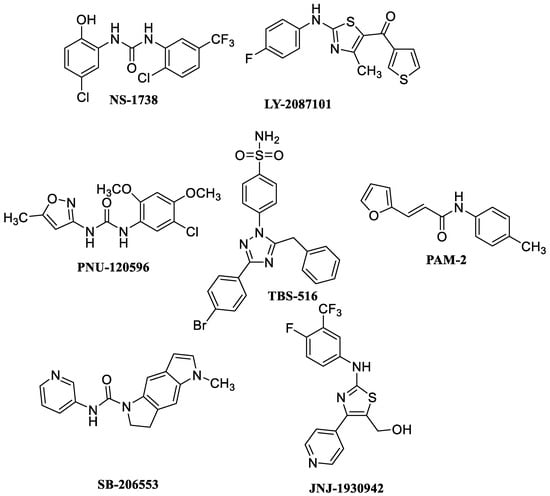
Figure 1.
Examples of type I, type II and type I/type II intermediate α7-positive allosteric modulators (PAMs).
4. Allosteric Activating PAMs
The compounds called allosteric activating PAMs (i.e., ago-PAMs) have intrinsic agonistic activity in the absence of an agonist, through interaction with an allosteric site(s) in the N-terminal extracellular domain (ECD). Ago-PAMs such as 4BP-TQS, (+)-GAT 107, and B-973 exhibit this particular pharmacological behavior (Figure 2). Since the dose–response curve for 4BP-TQS is faster and greater than those observed with agonists, it is believed that receptor activation is achieved with minimal desensitization through a different allosteric site [3]. It has been shown that 4BP-TQS was able to allosterically activate only the α7 receptor, while it behaves as an antagonist at α3β4, α4β2, and muscle-type receptors [37]. The direct allosteric activation of ago-PAMs is mediated by interactions at the archetypical transmembrane domain (TMD) site for type II PAMs and a novel direct allosteric activation (DAA) binding site located in ECD of the receptor distinct from both the orthosteric agonist and PAM sites [16,38,39]. B-973 is an α7 PAM which slows down ACh-induced receptor desensitization and noticeably increases ACh apparent potency, supporting a type II PAM pharmacological profile. However, B-973 behaves as an ago-PAM at high concentrations, thus having a dual concentration-dependent pharmacological behavior [40].
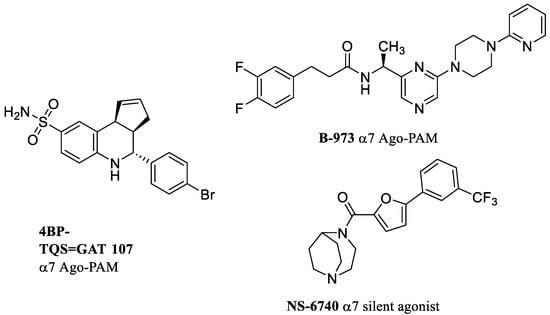
Figure 2.
Examples of allosteric activating PAMs (Ago-PAM) and silent agonist.
5. Silent Allosteric Modulators
Neutral allosteric ligands (NALs) or silent allosteric modulators (SAMs) block the efficacy or potency of PAMs as they bind to the same allosteric sites, without affecting the response to agonists [41,42]. In other words, SAMs may act as antagonists of PAMs [42]. For example, some derivatives with general formula 2 can behave as silent allosteric modulators.
6. Silent Agonists
Silent agonists or “silent desensitizers” are very weak partial agonists that bind to the orthosteric site, and are capable of inducing a stable and prolonged receptor desensitization which is sufficient to block the action of other agonists [43,44]. Silent agonists-induced desensitization can be achieved without prior receptor activation, and PAMs can destabilize this desensitization by restoring the receptor in an open state. However, silent agonists are not to be confused with competitive antagonists, which are able to block the interaction of agonists with the receptor through a mechanism insensitive to PAMs. For example, NS-6740 (Figure 2) is an α7 silent agonist [45] and the co-application of this compound and a type II PAM is in fact able to restore receptor activity [46,47,48].
7. Allosteric Modulatory Sites at α7 nAChRs
Allosteric modulators bind to sites topographically distinct from the orthosteric sites, and are able to modulate either positively (PAMs) or negatively (so called negative allosteric modulators or NAMs) the transition states of the receptor triggered by an agonist (i.e., gating). Potential allosteric sites for PAMs have been identified in different nAChR subtypes. For example, type I α7-PAMs bind to overlapping sites at the ECD, whereas type II α7-PAMs bind to an α7/α7 intersubunit site located in the middle of the TMD comprising the M2/M3 segments [49,50]; PAM-2 (Figure 1), another type II α7-PAMs, seems to also interact with an α7/α7 intersubunit site and with the ECD-TMD junction [31].
Ca2+ ions were the first PAMs identified at α7 nAChRs. The Ca2+-binding sites were recognized through site-directed mutagenesis studies and located in particular in the ECD clustered near the interface with the TMD [51]. Other divalent cations, such as Ba2+ and Sr2+, also positively modulate α7 nAChRs interacting with the same cation modulatory site in the α7 ECD [52,53].
8. α7 PAMs
The chemical structure of PAMs is quite heterogeneous, and only some pharmacophore properties were elucidated. Some PAM derivatives were obtained from GABAA PAM libraries, based on the homology between α7 nACh and GABAA receptors [4], which belong to the same superfamily of LGICs. Structural modifications have made it possible to obtain α7 selective derivatives such as AVL-3288 [4]. Another approach, particularly exploited by medicinal chemists is the high-throughput compound screening technique, which made it possible to obtain most of the PAMs that will be analyzed in this review, confirming the structural heterogeneity of allosteric modulators. The screening of libraries of small natural molecules has also allowed to obtain PAMs for different nAChR subtypes (vide infra).
The first allosteric modulator reported in the literature is 5-hydroxyindole (5-HI) (Figure 3), a type I PAM that significantly increases ACh evoked currents with potency EC50 0.63 μM, but minimal effects on the rapid desensitization of the hα7 receptor. Although 5-HI is selective for the α7 receptor with respect to other nAChR subtypes, it also modulates the 5-HT3 receptor [54].
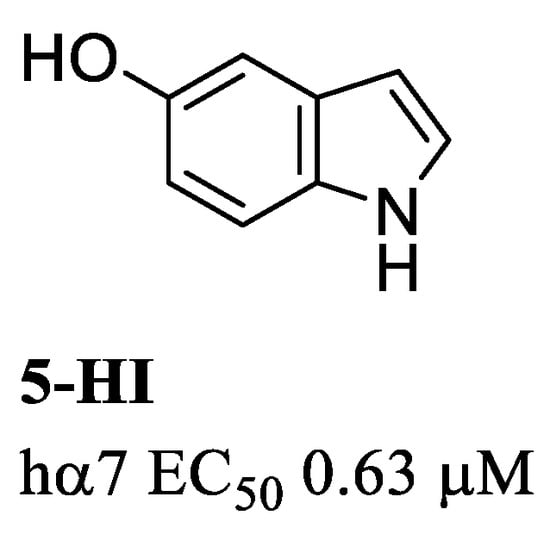
Figure 3.
Structure of the first type I PAM discovered.
Another potent type I PAM is NS-1738 (Figure 4), with good selectivity towards other nAChR subtypes. NS-1738, considered the archetype of type I PAMs, has pro-cognitive properties in vivo, even showing a modest brain:plasma ratio of 0.50 in rat and, consequently, a relatively modest brain penetration [55]. PNU-120596 is the first potent α7-PAM (EC50 = 0.16 μM at the hα7) that induces a drastic reduction in receptor desensitization. In this regard, this compound is considered the archetype of type II α7-PAMs.
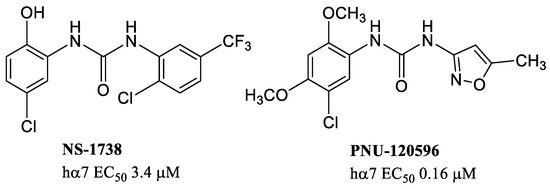
Figure 4.
Allosteric modulators with an ureidic function.
PNU-120596 exhibits the same ureidic function as in NS-1738 (EC50 = 3.4 μM at the hα7), but with differences in one of the two aromatic rings (Figure 4). In particular, the substituted phenyl in NS-1738 is transformed in an isoxazole ring which leads to particularly evident pharmacological differences.
PNU-120596 is among the best studied PAM in preclinical models of pain, ischemia, schizophrenia, and cognitive deficits as well as in clinical trials for the treatment of Alzheimer’s disease and schizophrenia [56]. Unfortunately, this compound has not been approved by the FDA. An important reason is that this PAM can induce cellular toxicity and death [57].
PNU-120596 binds into the TMD interface of two adjacent α7/α7 subunits. The cryogenic electron microscopy (cryo-EM) structure of the human α7 nAChR in different states and the molecular details of the PNU-bound interface have been recently described [58]. The different pharmacological profile of type I or II PAMs depends on the site to which they bind. Minimal chemical differences such as those highlighted between NS-1738 and PNU-120596, result in extremely different modulatory activity as well as distinct binding sites (Figure 5).
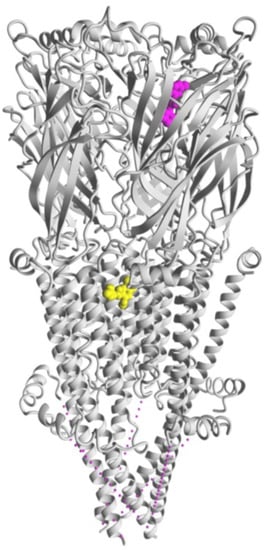
Figure 5.
Cryo-EM structure of the human α7 nAChR (pdb:7EKT) showing the intersubunit site for PNU-120596 (yellow), the archetype of type II PAMs, located in the TMD (modified from reference [58]). The ECD binding site for NS-1738 (magenta), a typical type I PAM, was obtained by molecular docking as previously described [31]. Only one of five sites per each PAM is shown for simplicity.
Numerous type I PAMs have been described in recent years obtained, as mentioned before, via high-throughput compound screening. Compounds such as LY-2087101, LY-2087133, and LY-1078733 (Figure 6) have low selectivity for α7, being also PAMs at the α2β4, α4β2, and α4β4 subtypes [59]. The modulation of both α7 and non-α7 receptor subtypes expressed centrally can be useful for the study of pathologies in which these receptors are involved, including depression, anxiety, addiction, chronic pain, and cognitive impairment, to name the most notorious and consequently in the development of novel medications.

Figure 6.
Examples of non-selective αAChR PAMs.
RO5126946, discovered and characterized by Roche through screening of arylsulfonamide small-libraries, is pharmacologically classified as a type II PAM. RO5126946 increases the peak amplitude of agonist-evoked current (EC50 = 0.06 μM at the hα7) and delays receptor desensitization. Unlike type II PAMs, however, it is unable to reactivate desensitized α7 receptors [60]. The derivative BNC375, with the same arylsufonamide function as in RO5126946 but with an alkylamino chain instead of an amide, has been classified as type I PAM or type II PAM depending on the stereochemistry around the central cyclopropyl ring (Figure 7). BNC375 and its analogs with stereochemistry (R,R) are identified as type I PAMs, while compounds of the same series with stereochemistry (S,S) are identified as type II PAMs. Furthermore, (R,R) BNC375 has a much lower peak current enhancement than its (S,S) enantiomer, increasing ACh signal without modifying receptor desensitization. Modifications made on the ortho-substituents, in particular with electron-withdrawing groups, lead to derivatives with reduced type II PAM characteristics, while electron-donating substituents have a stronger effect in delaying desensitization, indicating that the electron density of the aniline group plays a crucial role in the modulation of desensitization kinetic and therefore in the type I vs. type II PAM profile [61].
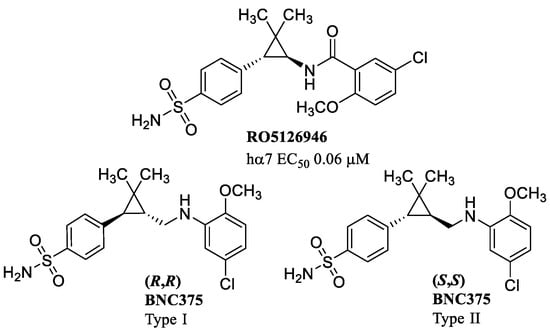
Figure 7.
Examples of type I and type II α7-PAMs with a cyclopropane ring.
The amide function is also present in another series of compounds, including PAM-2 (EC50 = 4.6 μM at the hα7) and PAM-4 (EC50 = 5.5 μM at the hα7) (Figure 8), which enhance agonist-evoked Ca2+ influx in the hα7 with potencies higher than the inhibitory activity at other non-α7 nAChRs [62]. These α7-PAMs were able to reactivate desensitized receptors with EC50 values similar to that for potentiation, supporting a type II PAM profile [36]. The important pharmacophoric elements for PAM-4 activity are the furyl ring, where this moiety is arranged as π–π stacking with Tyr232 and the oxygen forms a H-bond with the same residue at one α7 subunit, and the amide function, where the carbonyl forms a H-bond with Asp236 on the adjacent α7 subunit [Arias, manuscript in preparation]. PAM-2 shows pro-cognitive, promnesic, antidepressant-like and anxiolitic-like activities in mice [63,64,65,66].
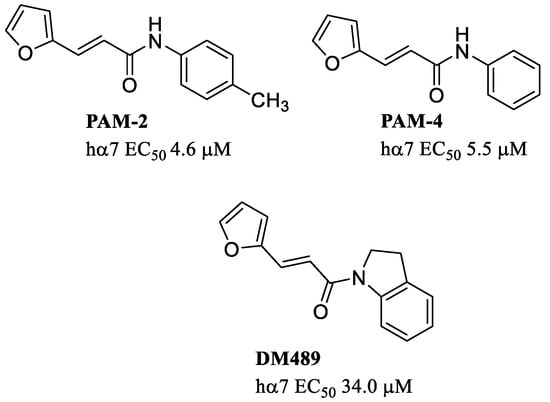
Figure 8.
Examples of PAMs with an amide function.
PAM-4, PAM-2 and its analog DM489 are able to reduce neuropathic pain, allodynia and inflammation in mice using different animal models [67,68].
To assess whether there is a direct correlation between the observed therapeutic effects and brain penetration, the blood–brain barrier permeability (i.e., LogBB) of several compounds was calculated [67,68]. A high brain permeability will allow the molecule to reach the brain target. The calculated LogBB values for PAM-2 (0.09), DM489 (0.17) and PAM-4 (−0.06) indicate that PAM-2 and DM489 not only have higher brain penetration than PAM-4, but also might induce more prolonged effects due to a potential higher accumulation in fatty tissues.
Other selective type II α7-PAMs with an arylsulfonamide ring are shown in Figure 9. Both TQS and A-867744 cause little or no activation of recombinant and native α7 nAChRs in the absence of an agonist. TQS, a naphtalenyl-cyclopentaquinoline derivative [69], has a potency (EC50 = 0.2 µM at the hα7) comparable to the ureidic derivative PNU-120596, and shows a typical type II PAMs profile with a massive potentiation of agonist-evoked responses and considerable reduction in the rate of desensitization [70]. A-867744 was able to potentiate ACh-evoked currents with an EC50 of ~1 µM but with much higher efficacy respect to that for TQS [71].
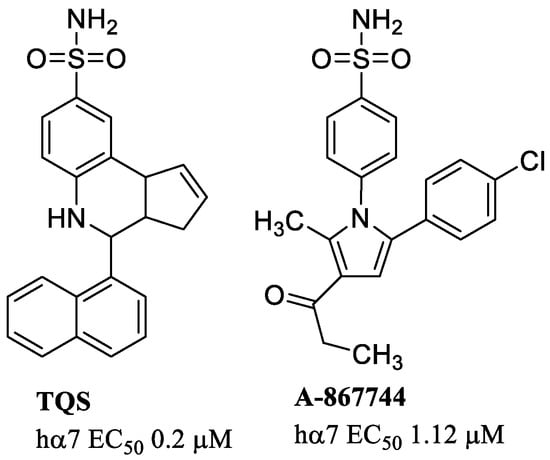
Figure 9.
Examples of type II α7-PAMs with arylsulfonamide ring.
PNU-120596 and A-867744 have been shown to bind to the same binding site and compete each other. In fact, the presence of A-867744 bound to the receptor slows down the modulation mediated by PNU-120596 by approximately 50 fold, and similarly A-867744 is unable to modulate the receptor if the binding sites are already saturated with PNU-120596 [72]. Through kinetic studies, the most obvious difference between the two compounds is the type of modulation mechanism that they produce. PNU-120596 has a limited ability to bind receptors in the resting state, while A-867744 easily associates to this conformation. Furthermore, PNU-120596 induces radically prolonged channel openings, while A-867744 acts by destabilizing the desensitized state rather than inducing the opening of the receptor. It has been observed that the opening and closing times of the channel cannot exceed 1 ms. Consequently, they act by increasing the mean open time, and not by forming an energetically stable open conformation. A-867744 therefore behaves both as a type II PAM in the prolonged and moderate presence of the agonist, and as a type I PAM after short agonist release pulses. Consequently, it has been shown that specific compounds classified as type II PAMs can behave in different ways. These different mechanisms of action can allow the attainment of derivatives with advantageous properties from a therapeutic point of view. For instance, A-867744-mediated modulation is fast, and has augmented onset and fast offset [72].
Other derivatives carrying a tetrahydro-cyclopenta[c]quinoline-8-sulfonamide (TQS) nucleus have been synthesized. They are structurally characterized by the presence of a phenyl ring carrying from 1 to 5 methyl groups in various positions, and by a different stereochemistry on the cyclopentaquinoline nucleus leading to the cis-cis or cis-trans isomers shown in Figure 10. The number and position of methyl substitution on the phenyl ring and the different stereochemical arrangement gave compounds with diverse pharmacological profiles. Cis-cis isomers 1 can be allosteric agonists or type II PAMs, while cis-trans isomers 2 can behave as type I PAMs, NAMs or SAMs [73]. The importance of the cis-cis isomerism in the activity as allosteric agonists is also confirmed by the derivative GAT-107 which is the cis-cis-(+) enantiomer of 4BP-TQS and which in fact acts as an allosteric agonist. Allosteric modulators are particularly sensitive to minimal changes in the chemical structure giving extremely different pharmacological profiles. “Knife-edge” structure–activity relationship is a characteristic of the allosteric ligands due to the fact that minimal chemical modifications can cause a change in activity from NAMs or SAMs to PAMs and vice versa [42]. This fact can be exploited by medicinal chemistry to achieve large pharmacological differences through minimal chemical changes.
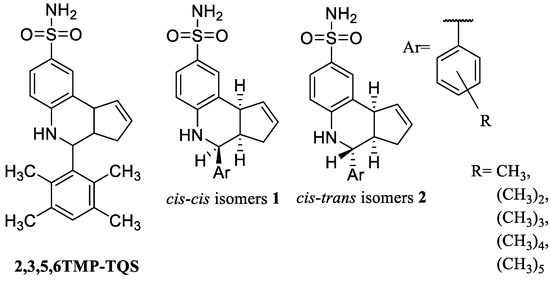
Figure 10.
Allosteric modulators with different pharmacological profile based on stereochemistry.
Optical isomerism can also affect the pharmacological profile of the modulators. Racemic 2,3,5,6TMP-TQS (Figure 10) was initially identified as SAM, since it has a silent behavior on the activation by 100 µM ACh interacting with an allosteric site, and as allosteric antagonist since it was able to reduce the activation by GAT-107 (structure reported in Figure 2) [16]. A deeper investigation on the activity of this racemate also showed an unexpected effect, the potentiation of the response to low doses of ACh. Indeed, the resolution of the racemic mixture demonstrated that the two enantiomers of 2,3,5,6TMP-TQS have a different activity: the (+) enantiomer behaves as a PAM, while the (−) enantiomer is an allosteric antagonist [74].
The arylsulfonamide group is a common feature of several molecules that exhibit an α7-PAM profile, such as the already mentioned A-867744 and TQS (Figure 9), and TBS-516 (EC50 = 0.4 μM at the hα7) (Figure 11). These three compounds differ in the core structure (pyrrole, cyclopenta[c]quinoline, or triazole) and in the organization of the groups on it. They are supposed to bind to the same intersubunit site, and thus their interactions are mutually exclusive. Docking studies have proposed a different orientation for A-867744 with respect to TQS and TBS-516, suggesting an explanation for its different functional activity on mutated receptors and pharmacological profile. A-867744, but not TQS and TBS-516, is able to displace the binding of α7-selective agonists interacting with the orthosteric site. This effect may be due to conformational changes in the receptor that are different from those caused by other PAMs [75].
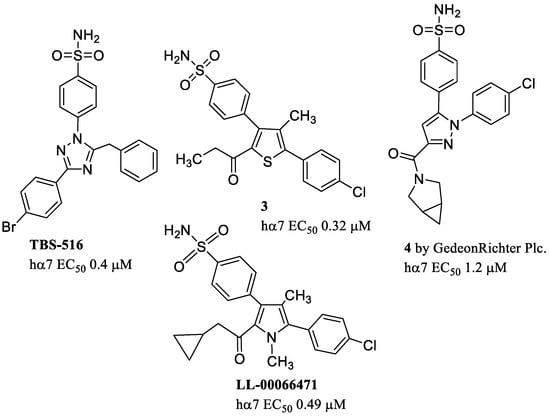
Figure 11.
Arylsulfonamide allosteric modulators.
Compound 3 [4-(5-(4-chlorophenyl)-4-methyl-2-propionylthiophen-3-yl) benzenesulfonamide], a structural derivative of A-867744 (Figure 11), is a potent (EC50 = 0.32 μM at the hα7) and selective α7-PAM. Phase 1 clinical trial indicated that compound 3 has a safe profile and excellent brain penetration. Furthermore, it demonstrates excellent efficacy in improving short-term episodic and working memory deficits in preclinical models of cognitive dysfunction. It is under development as monotherapy for mild and moderate Alzheimer’s disease [28].
A close structural analog, LL-00066471 (a type II PAM), shows high potency (EC50 = 0.49 μM at the hα7), and good brain permeability with a brain:plasma ratio around 1.5 in rats. LL-00066471 demonstrated high efficacy in animal models of cognitive and sensorimotor-gating deficits, supporting its potential use in the treatment of cognitive impairments associated with neurological and psychiatric conditions [76,77]. At Gedeon Richter Plc., A-867744 has been extensively modified to discover novel α7-PAMs. Among the synthesized molecules, pyrazole 4 has proved to be particularly interesting. It shows a significant potency (EC50 = 1.2 μM at the hα7) and efficacy for the α7 receptor and ability to improve cognitive performance in vivo in rodent models [78].
Through the screening of libraries of natural small molecules whose neuroprotective, anti-inflammatory, and pro-cognitive effects were known, various flavonoids were isolated, including the isoflavonoid genistein (EC50 = 9.36 μM at the hα7), the flavonol quercetin (EC50 = 15.39 μM at the hα7), and the neoflavonoid 5,7-dihydroxy-4-phenylcoumarin (EC50 = 9.64 μM at the hα7) (Figure 12). Although these natural compounds behave as type I α7-PAMs, they interact with an allosteric site located in the archetypical TMD site [79], suggesting that the interaction with the TMD site might induce type I- or type II-like effects depending on the respective affinities and transduction process at this site.
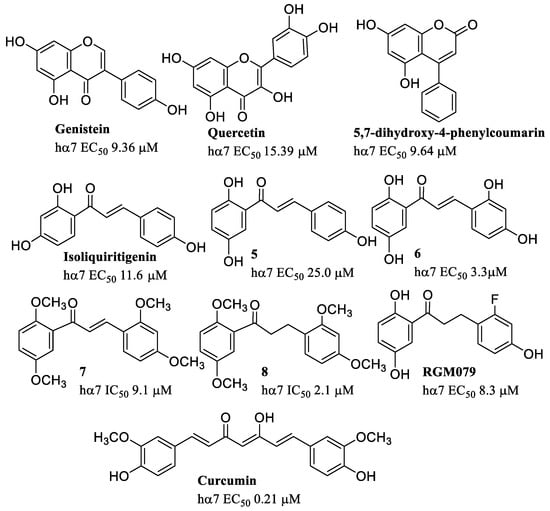
Figure 12.
α7-PAMs from natural sources.
Chalcone-like structures such as compounds 5 (EC50 = 25.0 μM) and 6 (EC50 = 3.3 μM), were obtained from isoliquiritigenin (EC50 = 11.6 μM), a major constituent of the Glycyrrhizae rhizoma, which showed specific activity as PAMs of the hα7. Of all the derivatives obtained through modifications in the number and position of phenolic functions, derivatives 5 and 6 proved to be the most interesting since, despite the minimal differences, derivative 5 behaves as a type I PAM, while derivative 6 behaves as a type II PAM [80]. The OCH3-substituted derivative 7 (IC50 = 9.1 μM at the hα7) acts as an α7-NAM, even if a higher inhibition was obtained with the saturated analogue 8 (IC50 = 2.1 μM at the hα7) [81]. The fluoro-substituted RGM079 (EC50 = 8.3 μM) of the polyhydroxy chalcones behaves as a potent PAM at the hα7 and shows neuroprotective properties in Alzheimer’s disease toxicity models [82].
Curcumin (EC50 = 0.21 μM at the hα7), which is the most abundant polyphenolic component extracted from turmeric, the rhizome of Curcuma longa, has long been used in traditional medicine as an anti-inflammatory, anticancer, antioxidant, and antimicrobial. Other beneficial effects have also been shown in animal model of Alzheimer’s and Parkinson’s disease, but the mechanism of action is not known [83]. Several phase 2 clinical trials of curcumin for mild cognitive impairment and mild to moderate Alzheimer’s disease have been completed, but results are unknown. Recently, the effects of curcumin on human α7 receptors have been investigated and curcumin has been shown to act as a PAM. It markedly decreases receptor desensitization and reactivates desensitized receptors, thus acting as type II PAM. This mechanism of action could therefore be responsible for the analgesic and anti-inflammatory actions of this compound [84].
The α7-PAMs JNJ39393406 and AVL-3288, and the α7 silent agonist ASM-024 (Figure 13) showed good preclinical profiles but unfortunately JNJ39393406 and AVL-3288 did not show efficacy in clinical trials. JNJ39393406 has completed two phase II trials for smoking cessation and another trial to treat cognitive or depressive symptoms in patients with unipolar depression [85,86], while the trials for schizophrenia and Alzheimer’s disease were terminated. AVL-3288 has completed a phase I trial for the treatment of schizophrenia and schizoaffective disorders [87]. The clinical results showed that although this compound was well tolerated at different doses, it improved neither the primary target engagement (P50) nor cognitive outcomes in schizophrenia, indicating lack of efficacy for AVL-3288. ASM-024 has completed phase II trials for the treatment of chronic obstructive pulmonary disease, mild allergic asthma, and asthma, respectively [88]. The results indicated that this PAM improves bronchial airway hyperreactivity and asthma induced by methacholine but not induced by allergens.
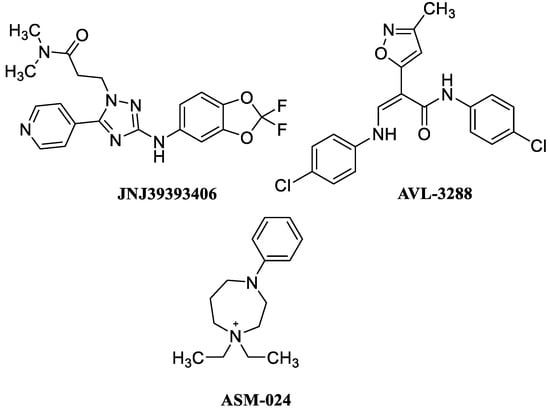
Figure 13.
Nicotinic agents in clinical trials by U.S. National Institutes of Health.
9. Positive Allosteric Modulators of the α4β2 nAChR
The heteromeric α4β2 nAChR subtype constitutes approximately 10–37% of the total nAChRs, depending on the various brain regions [89]. α4β2 nAChRs can have different stoichiometries with distinct functional properties and different sensitivity towards agonists: the low-sensitive (LS) (α4)3(β2)2 stoichiometry and the high-sensitive (HS) (α4)2(β2)3 stoichiometry. The HS subtype is most strongly affected by chronic nicotine exposure, causing a marked nicotine-induced potentiation, in the brain of rodents. Post-mortem studies on smokers’ brains have confirmed an increased expression of this receptor [90]. Moreover, HS is the most sensitive to desensitization induced by low agonist concentrations, although the LS stoichiometry has a faster desensitization kinetics than the HS receptor [91].
TC-5214 ((S)-(+)-mecamylamine) is both a PAM modulator of the HS stoichiometry and a selective and more efficacious blocker of LS stoichiometry, than TC-5213 ((R)-(−)-mecamylamine) [92]. Mecamylamine isomers differ in the interaction at binding sites in the TMD which could explain the different pharmacological profile of each isomer at each stoichiometry [93]. Given the complexity of the α4β2 subtype, in recent years medicinal chemistry has increased attention on the stoichiometry-selective allosteric modulation of this receptor even if the number of α4β2 allosteric activators is still rather limited [94].
des-Formylflustrabromine (dFBr) (Figure 14), one of the 22 alkaloids isolated from the marine organism Flustra foliacea, is the first PAM with high selectivity for the α4β2 nAChR subtype, potentiating the action of ACh and other agonists [95]. dFBr increases cognition in both naïve and cognitively impaired rats, supporting the strategy of using α4β2 PAMs for the treatment of cognitive deficits [96]. dFBr has been used as a unique lead for structure–activity relationship studies to understand what structural features are important for potentiation and/or inhibition of the ACh activity.
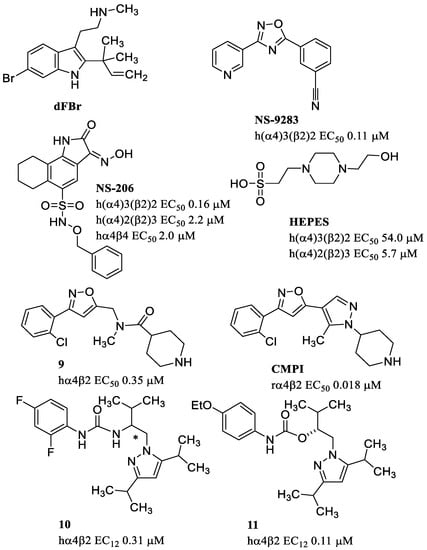
Figure 14.
Allosteric modulators of the α4β2 nAChR.
Various cations, such as zinc (Zn2+) and calcium (Ca2+) [97,98], seem to play crucial roles in the modulation of various nAChR subtypes in the brain. Co-application of Zn2+ (50 µM) with a saturating ACh concentration was shown to potentiate ACh-evoked currents by 260% [99]. It was also observed that Zn2+ at high concentrations inhibits (IC50 = 440 µM) different nAChR subtypes (i.e., α2β2, α2β4, α3β4, α4β2, and α4β4), while at low concentrations it potentiates (EC50 = 16 µM) the same subunit combinations [99]. In any case, Zn2+ does not affect the desensitization rate of nAChRs regardless of the combination of subunits. The Zn2+ cation can produce positive and negative modulation on the α4β2 nAChR by binding to two different domains. Furthermore, the allosteric modulation mediated by Zn2+ depends on the receptor stoichiometry: the allosteric inhibition on both receptor stoichiometries is due to the coordination of zinc at sites in the β2(+)/α4(−) interface, while if the stoichiometry is 3:2 the coordination of zinc in the α4(+)/α4(−) interface induces allosteric potentiation [97,100].
NS-9283, discovered by NeuroSearch A/S, modulates only the α4β2 LS stoichiometry (3:2) (EC50 = 0.11 μM), and the binding site was shown to be associated with the α4(+)/α4(−) interface only present in this stoichiometry [101]. NS-9283 acts as a PAM on (α2)3(β2)2, (α2)3(β4)2, (α4)3(β2)2, and (α4)3(β4)2 subtypes with relatively equivalent potency. On receptors containing the α3 subunit as well as in the stoichiometric combination 2α:3β, NS-9283 has no effect [102]. Therefore, this different receptor stoichiometry can be fundamental for having selective PAMs as evidenced for Zn2+ and NS-9283 which are completely selective towards the LS (α4)3(β2)2 receptors. Unlike NS-9283, NS-206 modulates both 2α:3β and 3α:2β stoichiometries of the α4β2 nAChR (EC50 = 2.2 and 0.16 μM, respectively). Interestingly, the modulatory activity is due to the α4 subunit, while the β-subunit has no influence. In fact, the same PAM activity is present on both α4β2 and α4β4 combinations [101].
HEPES [4-(2-hydroxyethyl)-1-piperazineethanesulfonic acid] is able to discriminate between LS and HS α4β2 receptors. More specifically, HEPES potentiates HS α4β2 receptors (EC50 = 5.7 μM) in the µM concentration range with little effect on LS α4β2 receptors (EC50 = 54.0 μM). As previously stated, the HS (α4)2(β2)3 stoichiometry has a β2(+)/β2(−) interface which is not present in the LS stoichiometry. Since mutagenesis studies showed that the mutation on β2-D218, at the β(+) face, abolishes HEPES potentiation, the allosteric site was located precisely at the β2(+)/β2(−) interface of the HS α4β2 subtype [103].
CMPI was discovered by Amgen Inc. through modifications starting from the piperidinamide 9, which had been identified through a high-throughput screening. To increase efficacy and potency, Albrecht and coworkers inserted bioisosters of the amide group such as pyrazole, thiazole, or imidazole. A series of interesting derivatives acting as potent modulators of the rat and human α4β2 receptors were thus obtained, capable of penetrating the CNS in an excellent manner [104]. CMPI was able to discriminate the two stoichiometric combinations of α4β2 receptors. More precisely, CMPI positively modulated LS α4β2 (3:2) but not HS α4β2 (2:3) nAChRs [105,106]. Amgen Inc. also discovered carbamates as α4β2 receptor enhancers starting from a lead compound (10) with an urea function and a stereogenic center. The (R) enantiomer was a moderate potentiator with selectivity for hα4β2 over hα3β2 and hα3β4. Potency and efficacy were improved transforming the urea into carbamate, and changing the substituents on the phenyl ring to give 11, which is an enhancer of the α4β2 receptor [107].
Regarding the allosteric modulatory sites at the α4β2 nAChR [49,51], the PAM site for galantamine, medication used in the treatment of Alzheimer’s disease at doses lower than those for acetylcholinesterase inhibition [108], has been located in the ECD within the α subunit at ~12 Å from the agonist site [109,110]. The site for Zn2+ is located on the ECD, involving non-canonical residues within the β2(+)/α4(−) or α4(+)/α4(−) interface based on α4β2 stoichiometry as previously reported [111]. Neuronal AChRs have two zinc binding sites located at non-canonical subunit interfaces alternated with ACh sites at canonical subunit interfaces. Allosteric sites are also present in the cytoplasmatic domain for α4β2 nAChRs. The cytoplasmatic or intracellular domain (ICD) has several phosphorylation sites that can modulate receptor functions through intracellular signaling pathways [112].
Given the low number of identified α4β2 PAMs, much work still needs to be performed to understand the action that modulators have on receptors with different stoichiometry. α4β2 nAChRs have been studied as drug targets in different therapeutic areas [2] and the potential of α4β2 PAMs strongly encourages the exploration of these derivatives as potential treatments of different CNS pathologies.
10. Allosteric Modulators at Other Non-α7 nAChR Subtypes
AN6001 is the first allosteric modulator that has been identified and characterized (Figure 15) with selectivity for α6β2-containing nAChRs (i.e., α6β2*) (EC50 = 0.58 μM), and no modulatory activity on α4β2, α7, α3β4, and muscle-type receptors [113]. AN6001 increased the potency and efficacy at the human recombinant α6/β2β3, α6/α3β2β3 and a concatenated version of human α6/α3β2β3 assembled as β3–α6–β2–α6–β2. In addition, AN6001 increased agonist-induced dopamine release from striatal synaptosomes. Ongoing studies on the expression and function of α6β2* nAChRs in the brain will provide information not only on these receptors, but also on the potential use of ligands such as AN6001 as pharmacological tools for neurological conditions involving this receptor subtype.

Figure 15.
Allosteric modulator of α6β2*, α3β2, and α9α10 nAChR subtypes.
Morantel (Figure 15) is a widely used anthelmintic, not for human use, in worm infections, but already described as a PAM of hα3β2 nAChRs (EC50 = 60 μM) [114]. Morantel increases the current when applied together with ACh by binding to non-canonical sites in the β(+)/α(−) subunit interface [115,116].
α9α10 nAChRs expressed in cochlear hair cells consist exclusively of α9 and α10 subunits with different stoichiometries (α9)3(α10)2 and (α9)2(α10)3 [117]. The knowledge regarding the number of binding sites in the different stoichiometries as well as the contribution of each subunit to the binding sites is not fully known yet, even considering that the crystal structure of the ECD of the homomeric α9 subunit is available [118]. The pharmacology of α9α10 nAChRs is different compared to other nAChR subtypes. In addition to be inhibited by the classical competitive antagonist α-bungarotoxin, α9α10 nAChRs are blocked by nicotine [119], the GABAA receptor antagonist bicuculline, the glycine receptor antagonist strychnine, and the muscarinic receptor antagonist atropine, whereas the muscarinic agonist oxotremorine behaves as a partial agonist of this receptor subtype [120].
An exhaustive literature search provided evidence that ryanodine and ascorbic acid are modulators of α9α10 nAChRs (Figure 15). More specifically, ryanodine is an alkaloid obtained from the Ryania speciosa plant, known mostly for its use as an insecticide and for its action in the release of Ca2+ through channels known as ryanodine receptors. Ryanodine also modulates the potency and maximal response to ACh, supporting the classification of PAM at α9α10 nAChRs [121]. Ascorbic acid selectively potentiates ACh-evoked responses at α9α10 nAChRs, with no apparent effect at α4β2 and α7 nAChRs. Since ascorbic acid also has intrinsic partial agonist activity at α9α10 nAChRs, it has been hypothesized that it binds to an allosteric site that triggers receptor activation, and thus, behaving as an ago-PAM [122].
11. Negative Allosteric Modulators of nAChRs
Negative allosteric modulators (NAMs) inhibit agonist-evoked activity by inducing conformational changes in the receptor that decrease the probability of channel opening. Dehydronorketamine (DHNK) (Figure 16) is a NAM with higher selectivity for α7 over α3β4 nAChRs [123]. DHNK is a metabolite of the general anesthetic (R) (S)-ketamine, and the fast-acting antidepressant esketamine (i.e., (S)-ketamine). DHNK was able to prevent the increase in ethanol consumption induced by alcohol exposure during adolescence in rat [124].
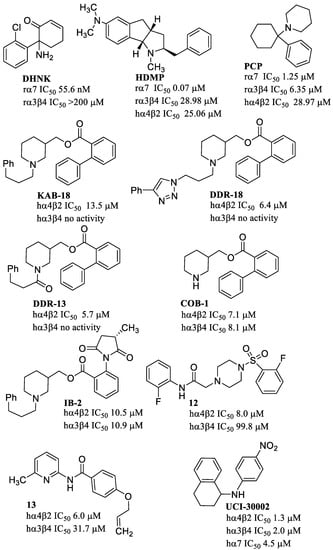
Figure 16.
Negative allosteric modulators (NAMs) of different nAChR subtypes.
1,2,3,3a,4,8b-haxahydro-2-benzyl-6-N,N-dimethylamino-1-methylindeno[1,2-b]pyrrole (HDMP), obtained by a conformationally restricted analogs of nicotine [125], shows 350-fold higher inhibitory potency on α7 than on α3β4 and α4β2. HDMP is thus an example of NAM with a good selectivity profile towards the α7 nAChRs. Phencyclidine (PCP) is an α7 NAM 18-fold less potent than HDMP with a different selectivity profile. In fact, PCP inhibits the α7 nAChR with potency 23-fold higher than that at the α4β2 nAChR, but similar as that for the α3β4 nAChR [126].
Several derivatives identified as NAMs are described in the literature which show a certain selectivity for the human α4β2 nAChRs with respect to hα3β4 nAChRs (Figure 16). These molecules were identified and characterized some years ago while no new compounds have been recently reported in the literature. Researchers at Ohio University discovered KAB-18 [127], a piperidine derivative showing selectivity for the hα4β2 over the hα3β4 subtype in recombinant systems [128]. The screening of a set of analogues (some are reported in Figure 16) allowed to derive some structure–activity relationships. The presence of the 2-biphenylcarboxylate ester group and 3-arylpropyl substituent on the piperidine nitrogen atom of the DDR-18 derivative was required for α4β2 selectivity. The piperidine nitrogen does not need to be basic, as the amide DDR18 has higher potency and similar selectivity with respect to KAB-18. Removal of the piperidine N-substituent, as in COB-1, abolished α4β2 selectivity. The same happen if the distal phenyl ring of the biphenyl moiety is replaced by amide or imide, as in IB-2. Studies to discriminate the activity of KAB-18 enantiomers showed similar potency and selectivity for the isomers.
The binding site of NAMs have been studied on α4β2 receptors. Homology modeling, blind docking, molecular dynamics studies, and targeted mutagenesis studies have determined the location of the allosteric binding site for NAMs at hα4β2 receptors. More precisely, the site was located in the interface between subunits α and β 10 Å apart from the orthosteric site [128,129,130]. Since most residues comprising the allosteric site are located on the β2 subunit, the site has been called “β subunit site”. Residues such as Thr58, Phe118, and Glu60, located on the β2 subunit, show <26% homology with other nAChR subunits. Phe118 and Thr58 are not present in hα4β2 and hα3β4. This low conservation could be responsible for the selectivity shown by some NAMs towards different subunits [131].
Virtual screening was applied by the same authors to identify new classes of compounds, exemplified by 12 [132] and 13 [131]. Compound 12, carrying a sulfonylpiperazine scaffold which is unique among NAMs previously described, shows approximately 12-fold selectivity for hα4β2 nAChR over the hα3β4 subtype. Although the potency of 13 is in the same range as that for 12, the selectivity for the hα4β2 subtype is 5-fold lower.
From the screening of a library of GABAA allosteric modulators, UCI-30002 was identified as a non-selective NAM of neuronal nAChRs. When tested in vivo, UCI-30002 blocks nicotine self-administration in rats at brain concentrations consistent with nAChR inhibition.
12. Concluding Remarks
Previous and current studies support the view that α7 and non-α7 nAChRs are involved in many physiological functions, and consequently, they are important targets in a variety of pathological conditions. Allosteric modulators have become the most interesting compounds for the development of new medications. Although there are no modulators in the market yet, several prospective compounds have demonstrated beneficial effects in clinical trial II (e.g., ASM-024), increasing the possibility of being approved for chronic obstructive pulmonary disease and asthma. We expect new promising candidates for a variety of neurological uses in the near future.
In addition to the obvious clinical interest, allosteric modulators can give us a different structural and functional perspective of how receptors are activated and desensitized compared to agonists. For example, if the main sites for type I and type II PAMs are, respectively, located in the ECD and TMD, what is the transduction mechanism involved in each interaction, and how agonist binding to the orthosteric site trigger these two different mechanisms?
It is very clear that different molecular structures can allosterically modulate distinct nAChR subtypes, and that small structural modifications induce important changes in the pharmacological profile of the studied compounds. The observed structural and functional flexibility of modulators will hopefully allow the development of novel compounds with improved receptor selectivity and efficacy for specific clinical uses, including neurological and non-neurological conditions.
Author Contributions
D.M. designed, wrote and revised the manuscript; H.R.A. wrote and revised the manuscript; M.N.R. helped editing the manuscript and gave scientific advisory; S.D., L.B., A.G. and E.T. revised the manuscript. All authors have read and agreed to the published version of the manuscript.
Funding
This work was supported by University of Florence Fondo Ricerca Ateneo RICATEN21.
Institutional Review Board Statement
Not applicable.
Informed Consent Statement
Not applicable.
Data Availability Statement
Not applicable.
Acknowledgement
The authors thank Targowska-Duda (Medical University of Lublin, Poland) for the preparation of Figure 5.
Conflicts of Interest
The authors declare no conflict of interest.
References
- Romanelli, M.N.; Gratteri, P.; Guandalini, L.; Martini, E.; Bonaccini, C.; Gualtieri, F. Central Nicotinic Receptors: Structure, Function, Ligands, and Therapeutic Potential. ChemMedChem 2007, 2, 746–767. [Google Scholar] [CrossRef] [PubMed]
- Manetti, D.; Bellucci, C.; Chiaramonte, N.; Dei, S.; Teodori, E.; Romanelli, M.N. Designing selective modulators for the nicotinic receptor subtypes: Challenges and opportunities. Future Med. Chem. 2018, 10, 433–459. [Google Scholar] [CrossRef] [PubMed]
- Gill, J.K.; Savolainen, M.; Young, G.T.; Zwart, R.; Sher, E.; Millar, N.S. Agonist activation of α7 nicotinic acetylcholine receptors via an allosteric transmembrane site. Proc. Natl. Acad. Sci. USA 2011, 108, 5867–5872. [Google Scholar] [CrossRef]
- Ng, H.J.; Whittemore, E.R.; Tran, M.B.; Hogenkamp, D.J.; Broide, R.S.; Johnstone, T.B.; Zheng, L.; Stevens, K.E.; Gee, K.W. Nootropic α7 nicotinic receptor allosteric modulator derived from GABAA receptor modulators. Proc. Natl. Acad. Sci. USA 2007, 104, 8059–8064. [Google Scholar] [CrossRef]
- Christensen, D.Z.; Mikkelsen, J.D.; Hansen, H.H.; Thomsen, M.S. Repeated administration of α7 nicotinic acetylcholine receptor (nAChR) agonists, but not positive allosteric modulators, increases α7 nAChR levels in the brain. J. Neurochem. 2010, 114, 1205–1216. [Google Scholar] [CrossRef]
- Wang, J.; Lindstrom, J. Orthosteric and allosteric potentiation of heteromeric neuronal nicotinic acetylcholine receptors. Br. J. Pharmacol. 2018, 175, 1805–1821. [Google Scholar] [CrossRef] [PubMed]
- Williams, D.K.; Wang, J.; Papke, R.L. Positive allosteric modulators as an approach to nicotinic acetylcholine receptor-targeted therapeutics: Advantages and limitations. Biochem. Pharmacol. 2011, 82, 915–930. [Google Scholar] [CrossRef] [PubMed]
- Arias, H.R. Binding sites for exogenous and endogenous non-competitive inhibitors of the nicotinic acetylcholine receptor. Biochim. Et Biophys. Acta (BBA)-Rev. Biomembr. 1998, 1376, 173–220. [Google Scholar] [CrossRef]
- Wang, H.; Sun, X. Desensitized nicotinic receptors in brain. Brain Res. Rev. 2005, 48, 420–437. [Google Scholar] [CrossRef]
- Quick, M.W.; Lester, R.A.J. Desensitization of neuronal nicotinic receptors. J. Neurobiol. 2002, 53, 457–478. [Google Scholar] [CrossRef]
- Charpantier, E.; Wiesner, A.; Huh, K.-H.; Ogier, R.; Hoda, J.-C.; Allaman, G.; Raggenbass, M.; Feuerbach, D.; Bertrand, D.; Fuhrer, C. α7 Neuronal Nicotinic Acetylcholine Receptors Are Negatively Regulated by Tyrosine Phosphorylation and Src-Family Kinases. J. Neurosci. 2005, 25, 9836–9849. [Google Scholar] [CrossRef] [PubMed]
- Taly, A.; Corringer, P.-J.; Guedin, D.; Lestage, P.; Changeux, J.-P. Nicotinic receptors: Allosteric transitions and therapeutic targets in the nervous system. Nat Rev Drug Discov 2009, 8, 733–750. [Google Scholar] [CrossRef] [PubMed]
- Canning, B.J.; Liu, Q.; Tao, M.; Devita, R.; Perelman, M.; Hay, D.W.; Dicpinigaitis, P.V.; Liang, J. Evidence for Alpha7 Nicotinic Receptor Activation During the Cough Suppressing Effects Induced by Nicotine and Identification of ATA-101 as a Potential Novel Therapy for the Treatment of Chronic Cough. J. Pharmacol. Exp. Ther. 2022, 380, 94–103. [Google Scholar] [CrossRef] [PubMed]
- Dajas-Bailador, F.A.; Mogg, A.J.; Wonnacott, S. Intracellular Ca2+ signals evoked by stimulation of nicotinic acetylcholine receptors in SH-SY5Y cells: Contribution of voltage-operated Ca2+ channels and Ca2+ stores. J. Neurochem. 2002, 81, 606–614. [Google Scholar] [CrossRef]
- Papke, R.L.; Bencherif, M.; Lippiello, P. An evaluation of neuronal nicotinic acetylcholine receptor activation by quaternary nitrogen compounds indicates that choline is selective for the α7 subtype. Neurosci. Lett. 1996, 213, 201–204. [Google Scholar] [CrossRef]
- Gulsevin, A.; Papke, R.L.; Stokes, C.; Garai, S.; Thakur, G.A.; Quadri, M.; Horenstein, N.A. Allosteric Agonism of α7 Nicotinic Acetylcholine Receptors: Receptor Modulation Outside the Orthosteric Site. Mol. Pharmacol. 2019, 95, 606–614. [Google Scholar] [CrossRef]
- Khiroug, S.S.; Harkness, P.C.; Lamb, P.W.; Sudweeks, S.N.; Khiroug, L.; Millar, N.S.; Yakel, J.L. Rat nicotinic ACh receptor α7 and β2 subunits co-assemble to form functional heteromeric nicotinic receptor channels. J. Physiol. 2002, 540, 425–434. [Google Scholar] [CrossRef]
- Williams, D.K.; Stokes, C.; Horenstein, N.A.; Papke, R.L. The effective opening of nicotinic acetylcholine receptors with single agonist binding sites. J. Gen. Physiol. 2011, 137, 369–384. [Google Scholar] [CrossRef]
- Papke, R.L.; Meyer, E.; Nutter, T.; Uteshev, V.V. α7 Receptor-selective agonists and modes of α7 receptor activation. Eur. J. Pharmacol. 2000, 393, 179–195. [Google Scholar] [CrossRef]
- Uteshev, V.V.; Meyer, E.M.; Papke, R.L. Activation and inhibition of native neuronal alpha-bungarotoxin-sensitive nicotinic ACh receptors. Brain Res. 2002, 948, 33–46. [Google Scholar] [CrossRef]
- Andersen, N.; Corradi, J.; Sine, S.M.; Bouzat, C. Stoichiometry for activation of neuronal α7 nicotinic receptors. Proc. Natl. Acad. Sci. USA 2013, 110, 20819–20824. [Google Scholar] [CrossRef] [PubMed]
- Revah, F.; Bertrand, D.; Galzi, J.L.; Devillers-Thiéry, A.; Mulle, C.; Hussy, N.; Bertrand, S.; Ballivet, M.; Changeux, J.P. Mutations in the channel domain alter desensitization of a neuronal nicotinic receptor. Nature 1991, 353, 846–849. [Google Scholar] [CrossRef]
- Mazurov, A.; Hauser, T.; Miller, C.H. Selective α7 Nicotinic Acetylcholine Receptor Ligands. Curr. Med. Chem. 2006, 13, 1567–1584. [Google Scholar] [CrossRef]
- Mazurov, A.A.; Speake, J.D.; Yohannes, D. Discovery and Development of α7 Nicotinic Acetylcholine Receptor Modulators. J. Med. Chem. 2011, 54, 7943–7961. [Google Scholar] [CrossRef]
- Hatton, G.I.; Yang, Q.Z. Synaptic Potentials Mediated by α7 Nicotinic Acetylcholine Receptors in Supraoptic Nucleus. J. Neurosci. 2002, 22, 29–37. [Google Scholar] [CrossRef] [PubMed]
- Uteshev, V.V. The therapeutic promise of positive allosteric modulation of nicotinic receptors. Eur. J. Pharmacol. 2014, 727, 181–185. [Google Scholar] [CrossRef]
- Uteshev, V.V. Allosteric Modulation of Nicotinic Acetylcholine Receptors: The Concept and Therapeutic Trends. Curr. Pharm. Des. 2016, 22, 1986–1997. [Google Scholar] [CrossRef]
- Sinha, N.; Karche, N.P.; Verma, M.K.; Walunj, S.S.; Nigade, P.B.; Jana, G.; Kurhade, S.P.; Hajare, A.K.; Tilekar, A.R.; Jadhav, G.R.; et al. Discovery of Novel, Potent, Brain-Permeable, and Orally Efficacious Positive Allosteric Modulator of α7 Nicotinic Acetylcholine Receptor [4-(5-(4-Chlorophenyl)-4-methyl-2-propionylthiophen-3-yl)benzenesulfonamide]: Structure–Activity Relationship and Preclinical Characterization. J. Med. Chem. 2020, 63, 944–960. [Google Scholar] [CrossRef]
- Papke, R.L.; Horenstein, N.A. Therapeutic Targeting of α7 Nicotinic Acetylcholine Receptors. Pharmacol. Rev. 2021, 73, 1118–1149. [Google Scholar] [CrossRef]
- Bertrand, D.; Gopalakrishnan, M. Allosteric modulation of nicotinic acetylcholine receptors. Biochem. Pharmacol. 2007, 74, 1155–1163. [Google Scholar] [CrossRef]
- Targowska-Duda, K.M.; Kaczor, A.A.; Jozwiak, K.; Arias, H.R. Molecular interactions of type I and type II positive allosteric modulators with the human α7 nicotinic acetylcholine receptor: An in silico study. J. Biomol. Struct. Dyn. 2019, 37, 411–439. [Google Scholar] [CrossRef]
- Chatzidaki, A.; D’oyley, J.M.; Gill-Thind, J.K.; Sheppard, T.D.; Millar, N.S. The influence of allosteric modulators and transmembrane mutations on desensitisation and activation of α7 nicotinic acetylcholine receptors. Neuropharmacology 2015, 97, 75–85. [Google Scholar] [CrossRef]
- Dunlop, J.; Lock, T.; Jow, B.; Sitzia, F.; Grauer, S.; Jow, F.; Kramer, A.; Bowlby, M.R.; Randall, A.; Kowal, D.; et al. Old and New Pharmacology: Positive Allosteric Modulation of the α7 Nicotinic Acetylcholine Receptor by the 5-Hydroxytryptamine2B/C Receptor Antagonist SB-206553 (3,5-Dihydro-5-methyl-N-3-pyridinylbenzo[1,2-b:4,5-b′]di pyrrole-1(2H)-carboxamide). J. Pharmacol. Exp. Ther. 2009, 328, 766–776. [Google Scholar] [CrossRef] [PubMed]
- Dinklo, T.; Shaban, H.; Thuring, J.W.; Lavreysen, H.; Stevens, K.E.; Zheng, L.; Mackie, C.; Grantham, C.; Vandenberk, I.; Meulders, G.; et al. Characterization of 2-[[4-Fluoro-3-(trifluoromethyl)phenyl]amino]-4-(4-pyridinyl)-5-thiazolemethanol (JNJ-1930942), a Novel Positive Allosteric Modulator of the α7 Nicotinic Acetylcholine Receptor. J. Pharmacol. Exp. Ther. 2011, 336, 560–574. [Google Scholar] [CrossRef] [PubMed]
- Jindrichova, M.; Lansdell, S.J.; Millar, N.S. Changes in Temperature Have Opposing Effects on Current Amplitude in α7 and α4β2 Nicotinic Acetylcholine Receptors. PLoS ONE 2012, 7, e32073. [Google Scholar] [CrossRef] [PubMed]
- Andersen, N.D.; Nielsen, B.E.; Corradi, J.; Tolosa, M.F.; Feuerbach, D.; Arias, H.R.; Bouzat, C. Exploring the positive allosteric modulation of human α7 nicotinic receptors from a single-channel perspective. Neuropharmacology 2016, 107, 189–200. [Google Scholar] [CrossRef]
- Gill, J.K.; Chatzidaki, A.; Ursu, D.; Sher, E.; Millar, N.S. Contrasting Properties of α7-Selective Orthosteric and Allosteric Agonists Examined on Native Nicotinic Acetylcholine Receptors. PLoS ONE 2013, 8, e55047. [Google Scholar] [CrossRef]
- Horenstein, N.A.; Papke, R.L.; Kulkarni, A.R.; Chaturbhuj, G.U.; Stokes, C.; Manther, K.; Thakur, G.A. Critical Molecular Determinants of α7 Nicotinic Acetylcholine Receptor Allosteric Activation: Separation of direct allosteric activation and positive allosteric modulation. J. Biol. Chem. 2016, 291, 5049–5067. [Google Scholar] [CrossRef]
- Antonio-Tolentino, K.; Hopkins, C.R. Selective α7 nicotinic receptor agonists and positive allosteric modulators for the treatment of schizophrenia—A review. Expert Opin. Investig. Drugs 2020, 29, 603–610. [Google Scholar] [CrossRef]
- Post-Munson, D.J.; Pieschl, R.L.; Molski, T.F.; Graef, J.D.; Hendricson, A.W.; Knox, R.J.; Mcdonald, I.M.; Olson, R.E.; Macor, J.E.; Weed, M.R.; et al. B-973, a novel piperazine positive allosteric modulator of the α7 nicotinic acetylcholine receptor. Eur. J. Pharmacol. 2017, 799, 16–25. [Google Scholar] [CrossRef]
- Conn, J.P.; Christopoulos, A.; Lindsley, C.W. Allosteric modulators of GPCRs: A novel approach for the treatment of CNS disorders. Nat. Rev. Drug Discov. 2009, 8, 41–54. [Google Scholar] [CrossRef] [PubMed]
- Noblin, D.; Bertekap, R.J.; Burford, N.; Hendricson, A.; Zhang, L.; Knox, R.; Banks, M.; O’connell, J.A.A. Development of a High-Throughput Calcium Flux Assay for Identification of All Ligand Types Including Positive, Negative, and Silent Allosteric Modulators for G Protein-Coupled Receptors. ASSAY Drug Dev. Technol. 2012, 10, 457–467. [Google Scholar] [CrossRef] [PubMed]
- Horenstein, N.A.; Papke, R.L. Anti-inflammatory Silent Agonists. ACS Med. Chem. Lett. 2017, 8, 989–991. [Google Scholar] [CrossRef] [PubMed]
- Papke, R.L.; Lindstrom, J.M. Nicotinic acetylcholine receptors: Conventional and unconventional ligands and signaling. Neuropharmacology 2020, 168, 108021. [Google Scholar] [CrossRef] [PubMed]
- Briggs, C.A.; Grønlien, J.H.; Curzon, P.; Timmermann, D.B.; Ween, H.; Thorin-Hagene, K.; Kerr, P.; Anderson, D.J.; Malysz, J.; Dyhring, T.; et al. Role of channel activation in cognitive enhancement mediated by α7 nicotinic acetylcholine receptors. Br. J. Pharmacol. 2009, 158, 1486–1494. [Google Scholar] [CrossRef] [PubMed]
- Blunt, C.E.W.; Dougherty, D.A. Binding Interactions of NS6740, a Silent Agonist of the α7 Nicotinic Acetylcholine Receptor. Mol. Pharmacol. 2019, 96, 212–218. [Google Scholar] [CrossRef]
- Pismataro, M.C.; Horenstein, N.A.; Stokes, C.; Quadri, M.; De Amici, M.; Papke, R.L.; Dallanoce, C. Design, synthesis, and electrophysiological evaluation of NS6740 derivatives: Exploration of the structure-activity relationship for alpha7 nicotinic acetylcholine receptor silent activation. Eur. J. Med. Chem. 2020, 205, 112669. [Google Scholar] [CrossRef]
- Pismataro, M.C.; Horenstein, N.A.; Stokes, C.; Dallanoce, C.; Thakur, G.A.; Papke, R.L. Stable desensitization of α7 nicotinic acetylcholine receptors by NS6740 requires interaction with S36 in the orthosteric agonist binding site. Eur. J. Pharmacol. 2021, 905, 174179. [Google Scholar] [CrossRef]
- Bertrand, D.; Bertrand, S.; Cassar, S.; Gubbins, E.; Li, J.; Gopalakrishnan, M. Positive Allosteric Modulation of the α7 Nicotinic Acetylcholine Receptor: Ligand Interactions with Distinct Binding Sites and Evidence for a Prominent Role of the M2-M3 Segment. Mol. Pharmacol. 2008, 74, 1407–1416. [Google Scholar] [CrossRef]
- Young, G.T.; Zwart, R.; Walker, A.S.; Sher, E.; Millar, N.S. Potentiation of alpha7 nicotinic acetylcholine receptors via an allosteric transmembrane site. Proc. Natl. Acad. Sci. USA 2008, 105, 14686–14691. [Google Scholar] [CrossRef]
- Cecchini, M.; Changeux, J.-P. The nicotinic acetylcholine receptor and its prokaryotic homologues: Structure, conformational transitions & allosteric modulation. Neuropharmacology 2015, 96, 137–149. [Google Scholar] [PubMed]
- Mclaughlin, J.T.; Barron, S.C.; See, J.A.; Rosenberg, R.L. Conformational changes in α7 acetylcholine receptors underlying allosteric modulation by divalent cations. BMC Pharmacol. 2009, 9, 1. [Google Scholar] [CrossRef] [PubMed]
- Eddins, D.; Lyford, L.K.; Lee, J.W.; Desai, S.A.; Rosenberg, R.L. Permeant but not impermeant divalent cations enhance activation of nondesensitizing α7 nicotinic receptors. Am. J. Physiol.-Cell Physiol. 2002, 282, C796–C804. [Google Scholar] [CrossRef]
- Zwart, R.; De Filippi, G.; Broad, L.M.; Mcphie, G.I.; Pearson, K.H.; Baldwinson, T.; Sher, E. 5-Hydroxyindole potentiates human α7 nicotinic receptor-mediated responses and enhances acetylcholine-induced glutamate release in cerebellar slices. Neuropharmacology 2002, 43, 374–384. [Google Scholar] [CrossRef] [PubMed]
- Timmermann, D.B.; Grønlien, J.H.; Kohlhaas, K.L.; Nielsen, E.Ø.; Dam, E.; Jørgensen, T.D.; Ahring, P.K.; Peters, D.; Holst, D.; Chrsitensen, J.K.; et al. An Allosteric Modulator of the α7 Nicotinic Acetylcholine Receptor Possessing Cognition-Enhancing Properties in Vivo. J. Pharmacol. Exp. Ther. 2007, 323, 294–307. [Google Scholar] [CrossRef] [PubMed]
- Chatzidaki, A.; Millar, N.S. Allosteric modulation of nicotinic acetylcholine receptors. Biochem. Pharmacol. 2015, 97, 408–417. [Google Scholar] [CrossRef]
- Guerra-Álvarez, M.; Moreno-Ortega, A.J.; Navarro, E.; Fernández-Morales, J.C.; Egea, J.; López, M.G.; Cano-Abad, M.F. Positive allosteric modulation of alpha-7 nicotinic receptors promotes cell death by inducing Ca2+ release from the endoplasmic reticulum. J. Neurochem. 2015, 133, 309–319. [Google Scholar] [CrossRef]
- Zhao, Y.; Liu, S.; Zhou, Y.; Zhang, M.; Chen, H.; Eric Xu, H.; Sun, D.; Liu, L.; Tian, C. Structural basis of human α7 nicotinic acetylcholine receptor activation. Cell Res. 2021, 31, 713–716. [Google Scholar] [CrossRef] [PubMed]
- Broad, L.M.; Zwart, R.; Pearson, K.H.; Lee, M.; Wallace, L.; Mcphie, G.I.; Emkey, R.; Hollinshead, S.P.; Dell, C.P.; Baker, S.R.; et al. Identification and pharmacological profile of a new class of selective nicotinic acetylcholine receptor potentiators. J. Pharmacol. Exp. Ther. 2006, 318, 1108–1117. [Google Scholar] [CrossRef]
- Sahdeo, S.; Wallace, T.; Hirakawa, R.; Knoflach, F.; Bertrand, D.; Maag, H.; Misner, D.; Tombaugh, G.C.; Santarelli, L.; Brameld, K.; et al. Characterization of RO5126946, a Novel α7 Nicotinic Acetylcholine Receptor–Positive Allosteric Modulator. J. Pharmacol. Exp. Ther. 2014, 350, 455–468. [Google Scholar] [CrossRef]
- Harvey, A.J.; Avery, T.D.; Schaeffer, L.; Joseph, C.; Huff, B.C.; Singh, R.; Morice, C.; Giethlen, B.; Grishin, A.A.; Coles, C.J.; et al. Discovery of BNC375, a Potent, Selective, and Orally Available Type I Positive Allosteric Modulator of α7 nAChRs. ACS Med. Chem. Lett. 2019, 10, 754–760. [Google Scholar] [CrossRef] [PubMed]
- Arias, H.R.; Gu, R.-X.; Feuerbach, D.; Guo, B.-B.; Ye, Y.; Wei, D.-Q. Novel Positive Allosteric Modulators of the Human α7 Nicotinic Acetylcholine Receptor. Biochemistry 2011, 50, 5263–5278. [Google Scholar] [CrossRef] [PubMed]
- Targowska-Duda, K.M.; Budzynska, B.; Michalak, A.; Jozwiak, K.; Biala, G.; Arias, H.R. 3-Furan-2-yl-N-p-tolyl-acrylamide, a highly selective positive allosteric modulator of α7 nicotinic receptors, produces anxiolytic-like activity in mice. J. Psychopharmacol. 2019, 33, 558–567. [Google Scholar] [CrossRef] [PubMed]
- Targowska-Duda, K.M.; Budzynska, B.; Michalak, A.; Wnorowski, A.; Loland, C.J.; Maj, M.; Manetti, D.; Romanelli, M.N.; Jozwiak, K.; Biala, G.; et al. Type I and type II positive allosteric modulators of α7 nicotinic acetylcholine receptors induce antidepressant-like activity in mice by a mechanism involving receptor potentiation but not neurotransmitter reuptake inhibition. Correlation with mTOR intracellular pathway activation. Eur. Neuropsychopharmacol. 2021, 52, 31–47. [Google Scholar] [CrossRef]
- Potasiewicz, A.; Hołuj, M.; Kos, T.; Popik, P.; Arias, H.R.; Nikiforuk, A. 3-Furan-2-yl-N-p-tolyl-acrylamide, a positive allosteric modulator of the α7 nicotinic receptor, reverses schizophrenia-like cognitive and social deficits in rats. Neuropharmacology 2017, 113 (Pt A), 188–197. [Google Scholar] [CrossRef]
- Phenis, D.; Vunck, S.A.; Valentini, V.; Arias, H.; Schwarcz, R.; Bruno, J.P. Activation of alpha7 nicotinic and NMDA receptors is necessary for performance in a working memory task. Psychopharmacology 2020, 237, 1723–1735. [Google Scholar] [CrossRef] [PubMed]
- Bagdas, D.; Sevdar, G.; Gul, Z.; Younis, R.; Cavun, S.; Tae, H.-S.; Ortells, M.O.; Arias, H.R.; Gurun, M.S. (E)-3-furan-2-yl-N-phenylacrylamide (PAM-4) decreases nociception and emotional manifestations of neuropathic pain in mice by α7 nicotinic acetylcholine receptor potentiation. Neurol. Res. 2021, 43, 1056–1068. [Google Scholar] [CrossRef]
- Arias, H.R.; Ghelardini, C.; Lucarini, E.; Tae, H.-S.; Yousuf, A.; Marcovich, I.; Manetti, D.; Romanelli, M.N.; Elgoyhen, A.B.; Adams, D.J.; et al. (E)-3-Furan-2-yl-N-p-tolyl-acrylamide and its Derivative DM489 Decrease Neuropathic Pain in Mice Predominantly by α7 Nicotinic Acetylcholine Receptor Potentiation. ACS Chem. Neurosci. 2020, 11, 3603–3614. [Google Scholar] [CrossRef]
- Faghih, R.; Gopalakrishnan, M.; Briggs, C.A. Allosteric Modulators of the α7 Nicotinic Acetylcholine Receptor. J. Med. Chem. 2008, 51, 701–712. [Google Scholar] [CrossRef]
- Grønlien, J.H.; Håkerud, M.; Ween, H.; Thorin-Hagene, K.; Briggs, C.A.; Gopalakrishnan, M.; Malysz, J. Distinct Profiles of α7 nAChR Positive Allosteric Modulation Revealed by Structurally Diverse Chemotypes. Mol. Pharmacol. 2007, 72, 715–724. [Google Scholar] [CrossRef]
- Malysz, J.; Grønlien, J.H.; Anderson, D.J.; Håkerud, M.; Thorin-Hagene, K.; Ween, H.; Wetterstrand, C.; Briggs, C.A.; Faghih, R.; Bunnelle, W.H.; et al. In Vitro Pharmacological Characterization of a Novel Allosteric Modulator of α7 Neuronal Acetylcholine Receptor, 4-(5-(4-Chlorophenyl)-2-methyl-3-propionyl-1H-pyrrol-1-yl)benzenesulfonamide (A-867744), Exhibiting Unique Pharmacological Profile. J. Pharmacol. Exp. Ther. 2009, 330, 257–267. [Google Scholar] [CrossRef] [PubMed]
- Pesti, K.; Lukacs, P.; Mike, A. Type I-like behavior of the type II α7 nicotinic acetylcholine receptor positive allosteric modulator A-867744. PeerJ 2019, 7, e7542. [Google Scholar] [CrossRef]
- Gill-Thind, J.K.; Dhankher, P.; D’oyley, J.M.; Sheppard, T.D.; Millar, N.S. Structurally Similar Allosteric Modulators of α7 Nicotinic Acetylcholine Receptors Exhibit Five Distinct Pharmacological Effects. J. Biol. Chem. 2015, 290, 3552–3562. [Google Scholar] [CrossRef] [PubMed]
- Papke, R.L.; Garai, S.; Stokes, C.; Horenstein, N.A.; Zimmerman, A.D.; Abboud, K.A.; Thakur, G.A. Differing Activity Profiles of the Stereoisomers of 2,3,5,6TMP-TQS, a Putative Silent Allosteric Modulator of α7 nAChR. Mol. Pharmacol. 2020, 98, 292–302. [Google Scholar] [CrossRef] [PubMed]
- Newcombe, J.; Chatzidaki, A.; Sheppard, T.D.; Topf, M.; Millar, N.S. Diversity of Nicotinic Acetylcholine Receptor Positive Allosteric Modulators Revealed by Mutagenesis and a Revised Structural Model. Mol. Pharmacol. 2018, 93, 128–140. [Google Scholar] [CrossRef]
- Verma, M.K.; Goel, R.N.; Bokare, A.M.; Dandekar, M.P.; Koul, S.; Desai, S.; Tota, S.; Singh, N.; Nigade, P.B.; Patil, V.B.; et al. LL-00066471, a novel positive allosteric modulator of α7 nicotinic acetylcholine receptor ameliorates cognitive and sensorimotor gating deficits in animal models: Discovery and preclinical characterization. Eur. J. Pharmacol. 2021, 891, 173685. [Google Scholar] [CrossRef]
- Sinha, N.; Karche, N.P.; Tilekar, A.R.; Palle, V.P.; Kamboj, R.K. 4-(5-(4-chlorophenyl)-2-(2-cycloprylacetyl)-1,4-dimethyl-1H-pyrrol-3-yl)benzenesufonamide as alpha 7 nAChR Modulator. WO 2014195848 A1. 2014. [Google Scholar]
- Ledneczki, I.; Tapolcsányi, P.; Gábor, E.; Visegrády, A.; Vass, M.; Éles, J.; Holm, P.; Horváth, A.; Pocsai, A.; Mahó, S.; et al. Discovery of novel positive allosteric modulators of the α7 nicotinic acetylcholine receptor: Scaffold hopping approach. Eur. J. Med. Chem. 2021, 214, 113189. [Google Scholar] [CrossRef]
- Nielsen, B.E.; Bermudez, I.; Bouzat, C. Flavonoids as positive allosteric modulators of α7 nicotinic receptors. Neuropharmacology 2019, 160, 107794. [Google Scholar] [CrossRef]
- Balsera, B.; Mulet, J.; Fernández-Carvajal, A.; Torre-Martínez, R.D.L.; Ferrer-Montiel, A.; Hernández-Jiménez, J.G.; Estévez-Herrera, J.; Borges, R.; Freitas, A.E.; López, M.G.; et al. Chalcones as positive allosteric modulators of α7 nicotinic acetylcholine receptors: A new target for a privileged structure. Eur. J. Med. Chem. 2014, 86, 724–739. [Google Scholar] [CrossRef]
- Criado, M.; Balsera, B.; Mulet, J.; Sala, S.; Sala, F.; De La Torre-Martínez, R.; Fernández-Carvajal, A.; Ferrer-Montie, L.; Moreno-Fernández, S.; Miguel, M.; et al. 1,3-diphenylpropan-1-ones as allosteric modulators of α7 nACh receptors with analgesic and antioxidant properties. Future Med. Chem. 2016, 8, 731–749. [Google Scholar] [CrossRef]
- Pérez De Vega, M.J.; Fernandez-Mendivil, C.; De La Torre Martínez, R.; González-Rodríguez, S.; Mullet, J.; Sala, F.; Sala, S.; Criado, M.; Moreno-Fernández, S.; Miguel, M.; et al. 1-(2′,5′-Dihydroxyphenyl)-3-(2-fluoro-4-hydroxyphenyl)-1-propanone (RGM079): A Positive Allosteric Modulator of α7 Nicotinic Receptors with Analgesic and Neuroprotective Activity. ACS Chem. Neurosci. 2019, 10, 3900–3909. [Google Scholar] [CrossRef]
- Nelson, K.M.; Dahlin, J.L.; Bisson, J.; Graham, J.; Pauli, G.F.; Walters, M.A. The Essential Medicinal Chemistry of Curcumin. J. Med. Chem. 2017, 60, 1620–1637. [Google Scholar] [CrossRef] [PubMed]
- El Nebrisi, E.G.; Bagdas, D.; Toma, W.; Al Samri, H.; Brodzik, A.; Alkhlaif, Y.; Yang, K.-H.S.; Howarth, F.C.; Damaj, I.M.; Oz, M. Curcumin Acts as a Positive Allosteric Modulator of α7-Nicotinic Acetylcholine Receptors and Reverses Nociception in Mouse Models of Inflammatory Pain. J. Pharmacol. Exp. Ther. 2018, 365, 190–200. [Google Scholar] [CrossRef]
- Perkins, K.A.; Roy Chengappa, K.N.; Karelitz, J.L.; Boldry, M.C.; Michael, V.; Herb, T.; Gannon, J.; Brar, J.; Ford, L.; Rassnick, S.; et al. Initial Cross-Over Test of A Positive Allosteric Modulator of Alpha-7 Nicotinic Receptors to Aid Cessation in Smokers With Or Without Schizophrenia. Neuropsychopharmacology 2018, 43, 1334–1342. [Google Scholar] [CrossRef] [PubMed]
- Davidson, M.; Levi, L.; Park, J.; Nastas, I.; Ford, L.; Rassnick, S.; Canuso, C.; Davis, J.M.; Weiser, M. The effects of JNJ-39393406 a positive allosteric nicotine modulator on mood and cognition in patients with unipolar depression: A double-blind, add-on, placebo-controlled trial. Eur. Neuropsychopharmacol. 2021, 51, 33–42. [Google Scholar] [CrossRef] [PubMed]
- Kantrowitz, J.T.; Javitt, D.C.; Freedman, R.; Sehatpour, P.; Kegeles, L.S.; Carlson, M.; Sobeih, T.; Wall, M.M.; Choo, T.-H.; Vail, B.; et al. Double blind, two dose, randomized, placebo-controlled, cross-over clinical trial of the positive allosteric modulator at the alpha7 nicotinic cholinergic receptor AVL-3288 in schizophrenia patients. Neuropsychopharmacology 2020, 45, 1339–1345. [Google Scholar] [CrossRef]
- Boulet, L.-P.; Gauvreau, G.M.; Cockcroft, D.W.; Davis, B.; Vachon, L.; Cormier, Y.; O’byrne, P.M. Effects of ASM-024, a modulator of acetylcholine receptor function, on airway responsiveness and allergen-induced responses in patients with mild asthma. Can. Respir. J. 2015, 22, 230–23489. [Google Scholar] [CrossRef]
- Gotti, C.; Clementi, F.; Fornari, A.; Gaimarri, A.; Guiducci, S.; Manfredi, I. Structural and functional diversity of native brain nicotinic receptors. Biochem. Pharmacol. 2009, 78, 703–711. [Google Scholar] [CrossRef]
- Buisson, B.; Bertrand, D. Nicotine addiction: The possible role of functional upregulation. Trends Pharmacol. Sci. 2002, 23, 130–136. [Google Scholar] [CrossRef]
- Nelson, M.E.; Kuryatov, A.; Choi, C.H.; Zhou, Y.; Lindstrom, J. Alternate Stoichiometries of α4β2 Nicotinic Acetylcholine Receptors. Mol. Pharmacol. 2003, 63, 332–341. [Google Scholar] [CrossRef]
- Fedorov, N.B.; Benson, L.C.; Graef, J.; Lippiello, P.M.; Bencherif, M. Differential Pharmacologies of Mecamylamine Enantiomers: Positive Allosteric Modulation and Noncompetitive Inhibition. J. Pharmacol. Exp. Ther. 2009, 328, 525–532. [Google Scholar] [CrossRef] [PubMed]
- Bondarenko, V.; Targowska-Duda, K.M.; Jozwiak, K.; Tang, P.; Arias, H.R. Molecular Interactions between Mecamylamine Enantiomers and the Transmembrane Domain of the Human α4β2 Nicotinic Receptor. Biochemistry 2014, 53, 908–918. [Google Scholar] [CrossRef] [PubMed]
- Grupe, M.; Grunnet, M.; Bastlund, J.F.; Jensen, A.A. Targeting α4β2 Nicotinic Acetylcholine Receptors in Central Nervous System Disorders: Perspectives on Positive Allosteric Modulation as a Therapeutic Approach. Basic Clin. Pharmacol. Toxicol. 2015, 116, 187–200. [Google Scholar] [CrossRef]
- Kim, J.-S.; Padnya, A.; Weltzin, M.; Edmonds, B.W.; Schulte, M.K.; Glennon, R.A. Synthesis of desformylflustrabromine and its evaluation as an α4β2 and α7 nACh receptor modulator. Bioorg. Med. Chem. Lett. 2007, 17, 4855–4860. [Google Scholar] [CrossRef] [PubMed]
- Nikiforuk, A.; Litwa, E.; Krawczyk, M.; Popik, P.; Arias, H. Desformylflustrabromine, a positive allosteric modulator of α4β2-containing nicotinic acetylcholine receptors, enhances cognition in rats. Pharmacol. Rep. 2020, 72, 589–599. [Google Scholar] [CrossRef] [PubMed]
- Moroni, M.; Vijayan, R.; Carbone, A.; Zwart, R.; Biggin, P.C.; Bermudez, I. Non-Agonist-Binding Subunit Interfaces Confer Distinct Functional Signatures to the Alternate Stoichiometries of the α4β2 Nicotinic Receptor: An α4– α4 Interface Is Required for Zn2+ Potentiation. J. Neurosci. 2008, 28, 6884–6894. [Google Scholar] [CrossRef] [PubMed]
- Eiselé, J.-L.; Bertrand, S.; Galzi, J.-L.; Devillers-Thiéry, A.; Changeux, J.-P.; Bertrand, D. Chimaeric nicotinic–serotonergic receptor combines distinct ligand binding and channel specificities. Nature 1993, 366, 479–483. [Google Scholar] [CrossRef]
- Hsiao, B.; Dweck, D.; Luetje, C.W. Subunit-Dependent Modulation of Neuronal Nicotinic Receptors by Zinc. J. Neurosci. 2001, 21, 1848–1856. [Google Scholar] [CrossRef]
- Arias, H.R. Chapter 5 - Positive and negative modulation of nicotinic receptors. In Advances in Protein Chemistry and Structural Biology; Rossen, D., Ed.; Academic Press: Cambridge, MA, USA, 2010; Volume 80, pp. 153–203. [Google Scholar] [CrossRef]
- Olsen, J.A.; Kastrup, J.S.; Peters, D.; Gajhede, M.; Balle, T.; Ahring, P.K. Two Distinct Allosteric Binding Sites at α4β2 Nicotinic Acetylcholine Receptors Revealed by NS206 and NS9283 Give Unique Insights to Binding Activity-associated Linkage at Cys-loop Receptors. J. Biol. Chem. 2013, 288, 35997–36006. [Google Scholar] [CrossRef]
- Timmermann, D.B.; Sandager-Nielsen, K.; Dyhring, T.; Smith, M.; Jacobsen, A.M.; Nielsen, E.; Grunnet, M.; Christensen, J.K.; Peters, D.; Kohlhaas, K.; et al. Augmentation of cognitive function by NS9283, a stoichiometry-dependent positive allosteric modulator of α2- and α4-containing nicotinic acetylcholine receptors. Br. J. Pharmacol. 2012, 167, 164–182. [Google Scholar] [CrossRef]
- Weltzin, M.M.; Huang, Y.; Schulte, M.K. Allosteric modulation of alpha4beta2 nicotinic acetylcholine receptors by HEPES. Eur. J. Pharmacol. 2014, 732, 159–168. [Google Scholar] [CrossRef] [PubMed]
- Albrecht, B.K.; Berry, V.; Boezio, A.A.; Cao, L.; Clarkin, K.; Guo, W.; Harmange, J.-C.; Hierl, M.; Huang, L.; Janosky, B.; et al. Discovery and optimization of substituted piperidines as potent, selective, CNS-penetrant α4β2 nicotinic acetylcholine receptor potentiators. Bioorg. Med. Chem. Lett. 2008, 18, 5209–5212. [Google Scholar] [CrossRef] [PubMed]
- Wilkerson, J.L.; Deba, F.; Crowley, M.L.; Hamouda, A.K.; Mcmahon, L.R. Advances in the In vitro and In vivo pharmacology of Alpha4beta2 nicotinic receptor positive allosteric modulators. Neuropharmacology 2020, 168, 108008. [Google Scholar] [CrossRef] [PubMed]
- Deba, F.; Munoz, K.; Peredia, E.; Akk, G.; Hamouda, A.K. Assessing potentiation of the (α4)3(β2)2 nicotinic acetylcholine receptor by the allosteric agonist CMPI. J. Biol. Chem. 2022, 298, 101455. [Google Scholar] [CrossRef]
- Springer, S.K.; Woodin, K.S.; Berry, V.; Boezio, A.A.; Cao, L.; Clarkin, K.; Harmange, J.-C.; Hierl, M.; Knop, J.; Malmberg, A.B.; et al. Synthesis and activity of substituted carbamates as potentiators of the α4β2 nicotinic acetylcholine receptor. Bioorg. Med. Chem. Lett. 2008, 18, 5643–5647. [Google Scholar] [CrossRef]
- Hahn, B.; Reneski, C.H.; Lane, M.; Elmer, G.I.; Pereira, E.F.R. Evidence for positive allosteric modulation of cognitive-enhancing effects of nicotine by low-dose galantamine in rats. Pharmacol. Biochem. Behav. 2020, 199, 173043. [Google Scholar] [CrossRef]
- Iorga, I.; Herlem, D.; Barré, E.; Guillou, C. Acetylcholine nicotinic receptors: Finding the putative binding site of allosteric modulators using the “blind docking” approach. J. Mol. Mod. 2006, 12, 366–372. [Google Scholar] [CrossRef]
- Ludwig, J.; Höffle-Maas, A.; Samochocki, M.; Luttmann, E.; Albuquerque, E.X.; Fels, G.; Maelicke, A. Localization by site-directed mutagenesis of a galantamine binding site on α7 nicotinic acetylcholine receptor extracellular domain. J. Recept. Signal Transduct. 2010, 30, 469–483. [Google Scholar] [CrossRef]
- Hsiao, B.; Mihalak, K.B.; Repicky, S.E.; Everhart, D.; Mederos, A.H.; Malhotra, A.; Luetje, C.W. Determinants of Zinc Potentiation on the α4 Subunit of Neuronal Nicotinic Receptors. Mol. Pharmacol. 2006, 69, 27–36. [Google Scholar] [CrossRef]
- Hales, T.G.; Dunlop, J.I.; Deeb, T.Z.; Carland, J.E.; Kelley, S.P.; Lambert, J.J.; Peters, J.A. Common Determinants of Single Channel Conductance within the Large Cytoplasmic Loop of 5-Hydroxytryptamine Type 3 and α4β2 Nicotinic Acetylcholine Receptors*. J. Biol. Chem. 2006, 281, 8062–8071. [Google Scholar] [CrossRef]
- Van Hout, M.; Klein, J.; Ahring, P.K.; Brown, D.T.; Thaneshwaran, S.; Dos Santos, A.B.; Jensen, A.A.; Kohlmeier, K.A.; Christophersen, P.; Dyhring, T. Characterization of AN6001, a positive allosteric modulator of α6β2-containing nicotinic acetylcholine receptors. Biochem. Pharmacol. 2020, 174, 113788. [Google Scholar] [CrossRef] [PubMed]
- Wu, T.-Y.; Smith, C.M.; Sine, S.M.; Levandoski, M.M. Morantel Allosterically Enhances Channel Gating of Neuronal Nicotinic Acetylcholine α3β2 Receptors. Mol. Pharmacol. 2008, 74, 466–475. [Google Scholar] [CrossRef] [PubMed]
- Seo, S.; Henry, J.T.; Lewis, A.H.; Wang, N.; Levandoski, M.M. The Positive Allosteric Modulator Morantel Binds at Noncanonical Subunit Interfaces of Neuronal Nicotinic Acetylcholine Receptors. J. Neurosci. 2009, 29, 8734–8742. [Google Scholar] [CrossRef] [PubMed]
- Cohen, B.N.; Figl, A.; Quick, M.W.; Labarca, C.; Davidson, N.; Lester, H.A. Regions of beta 2 and beta 4 responsible for differences between the steady state dose-response relationships of the alpha 3 beta 2 and alpha 3 beta 4 neuronal nicotinic receptors. J. Gen. Physiol. 1995, 105, 745–764. [Google Scholar] [CrossRef] [PubMed]
- Elgoyhen, A.B. The α9α10 nicotinic acetylcholine receptor: A compelling drug target for hearing loss? Expert Opin. Ther. Targets 2022, 26, 291–302. [Google Scholar] [CrossRef] [PubMed]
- Zouridakis, M.; Papakyriakou, A.; Ivanov, I.A.; Kasheverov, I.E.; Tsetlin, V.; Tzartos, S.; Giastas, P. Crystal Structure of the Monomeric Extracellular Domain of α9 Nicotinic Receptor Subunit in Complex With α-Conotoxin RgIA: Molecular Dynamics Insights Into RgIA Binding to α9α10 Nicotinic Receptors. Front. Pharmacol. 2019, 10, 474. [Google Scholar] [CrossRef]
- Gómez-Casati, M.E.; Fuchs, P.A.; Elgoyhen, A.B.; Katz, E. Biophysical and pharmacological characterization of nicotinic cholinergic receptors in rat cochlear inner hair cells. J. Physiol. 2005, 566, 103–118. [Google Scholar] [CrossRef]
- Mcintosh, J.M.; Absalom, N.; Chebib, M.; Elgoyhen, A.B.; Vincler, M. Alpha9 nicotinic acetylcholine receptors and the treatment of pain. Biochem. Pharmacol. 2009, 78, 693–702. [Google Scholar] [CrossRef]
- Zorrilla De San Martín, J.; Ballestero, J.; Katz, E.; Elgoyhen, A.B.; Fuchs, P.A. Ryanodine is a Positive Modulator of Acetylcholine Receptor Gating in Cochlear Hair Cells. J. Assoc. Res. Otolaryngol. 2007, 8, 474–483. [Google Scholar] [CrossRef]
- Boffi, J.; Wedemeyer, C.; Lipovsek, M.; Katz, E.; Calvo, D.; Elgoyhen, A. Positive modulation of the α9α10 nicotinic cholinergic receptor by ascorbic acid. Br. J. Pharmacol. 2013, 168, 954–965. [Google Scholar] [CrossRef]
- Moaddel, R.; Abdrakhmanova, G.; Kozak, J.; Jozwiak, K.; Toll, L.; Jimenez, L.; Rosenberg, A.; Tran, T.; Xiao, Y.; Zarate, C.A.; et al. Sub-anesthetic concentrations of (R,S)-ketamine metabolites inhibit acetylcholine-evoked currents in α7 nicotinic acetylcholine receptors. Eur. J. Pharmacol. 2013, 698, 228–234. [Google Scholar] [CrossRef] [PubMed]
- Rodd, Z.A.; Hauser, S.R.; Swartzwelder, H.S.; Waeiss, R.A.; Lahiri, D.K.; Bell, R.L. Regulation of the deleterious effects of binge-like exposure to alcohol during adolescence by α7 nicotinic acetylcholine receptor agents: Prevention by pretreatment with a α7 negative allosteric modulator and emulation by a α7 agonist in alcohol-preferring (P) male and female rats. Psychopharmacology 2020, 237, 2601–2611. [Google Scholar] [CrossRef] [PubMed]
- Glassco, W.; Suchocki, J.; George, C.; Martin, B.R.; May, E.L. Synthesis, optical resolution, absolute configuration, and preliminary pharmacology of (+)- and (−)-cis-2,3,3a,4,5,9b-hexahydro-1-methyl-1H-pyrrolo[3,2-h]isoquinoline, a structural analog of nicotine. J. Med. Chem. 1993, 36, 3381–3385. [Google Scholar] [CrossRef] [PubMed]
- Abdrakhmanova, G.R.; Blough, B.E.; Nesloney, C.; Navarro, H.A.; Damaj, M.I.; Carroll, F.I. In vitro and in vivo characterization of a novel negative allosteric modulator of neuronal nAChRs. Neuropharmacology 2010, 59, 511–517. [Google Scholar] [CrossRef] [PubMed]
- González-Cestari, T.F.; Henderson, B.J.; Pavlovicz, R.E.; Mckay, S.B.; El-Hajj, R.A.; Pulipaka, A.B.; Orac, C.M.; Reed, D.D.; Boyd, R.T.; Zhu, M.X.; et al. Effect of Novel Negative Allosteric Modulators of Neuronal Nicotinic Receptors on Cells Expressing Native and Recombinant Nicotinic Receptors: Implications for Drug Discovery. J. Pharmacol. Exp. Ther. 2009, 328, 504–515. [Google Scholar] [CrossRef]
- Henderson, B.J.; Pavlovicz, R.E.; Allen, J.D.; González-Cestari, T.F.; Orac, C.M.; Bonnell, A.B.; Zhu, M.X.; Boyd, R.T.; Li, C.; Bergmeier, S.C.; et al. Negative Allosteric Modulators That Target Human α4β2 Neuronal Nicotinic Receptors. J. Pharmacol. Exp. Ther. 2010, 334, 761–774. [Google Scholar] [CrossRef]
- Henderson, B.J.; González-Cestari, T.F.; Yi, B.; Pavlovicz, R.E.; Boyd, R.T.; Li, C.; Bergmeier, S.C.; Mckay, D.B. Defining the Putative Inhibitory Site for a Selective Negative Allosteric Modulator of Human α4β2 Neuronal Nicotinic Receptors. ACS Chem. Neurosci. 2012, 3, 682–692. [Google Scholar] [CrossRef]
- Pavlovicz, R.E.; Henderson, B.J.; Bonnell, A.B.; Boyd, R.T.; Mckay, D.B.; Li, C. Identification of a Negative Allosteric Site on Human α4β2 and α3β4 Neuronal Nicotinic Acetylcholine Receptors. PLoS ONE 2011, 6, e24949. [Google Scholar] [CrossRef]
- Yi, B.; Long, S.; González-Cestari, T.F.; Henderson, B.J.; Pavlovicz, R.E.; Werbovetz, K.; Li, C.; Mckay, D.B. Discovery of benzamide analogs as negative allosteric modulators of human neuronal nicotinic receptors: Pharmacophore modeling and structure–activity relationship studies. Bioorg. Med. Chem. 2013, 21, 4730–4743. [Google Scholar] [CrossRef]
- Henderson, B.J.; Carper, D.J.; González-Cestari, T.F.; Yi, B.; Mahasenan, K.; Pavlovicz, R.E.; Dalefield, M.L.; Coleman, R.S.; Li, C.; Mckay, D.B. Structure–Activity Relationship Studies of Sulfonylpiperazine Analogues as Novel Negative Allosteric Modulators of Human Neuronal Nicotinic Receptors. J. Med. Chem. 2011, 54, 8681–8692. [Google Scholar] [CrossRef]
Disclaimer/Publisher’s Note: The statements, opinions and data contained in all publications are solely those of the individual author(s) and contributor(s) and not of MDPI and/or the editor(s). MDPI and/or the editor(s) disclaim responsibility for any injury to people or property resulting from any ideas, methods, instructions or products referred to in the content. |
© 2023 by the authors. Licensee MDPI, Basel, Switzerland. This article is an open access article distributed under the terms and conditions of the Creative Commons Attribution (CC BY) license (https://creativecommons.org/licenses/by/4.0/).